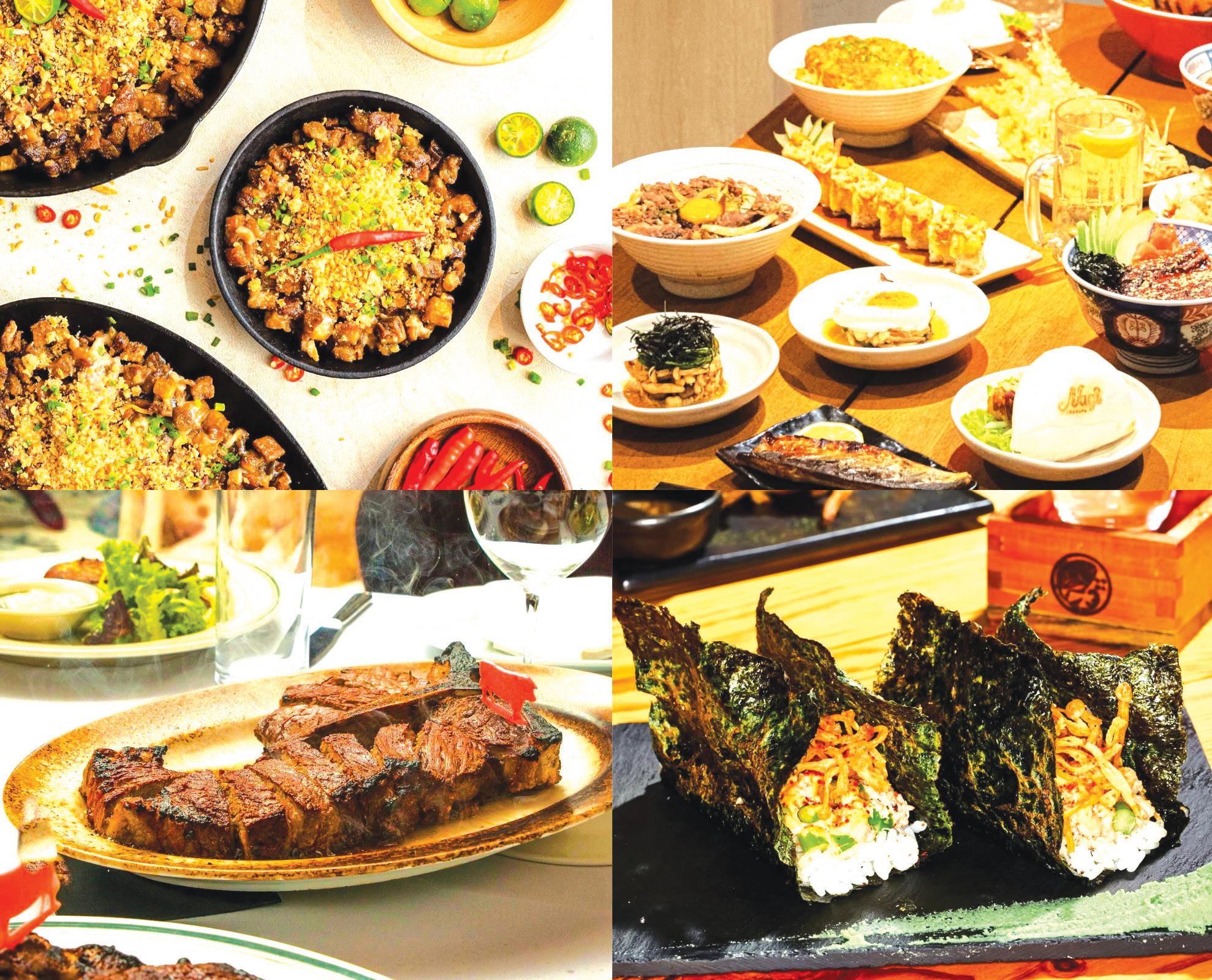






By Nicole Winfield & Colleen Barry












By Nicole Winfield & Colleen Barry





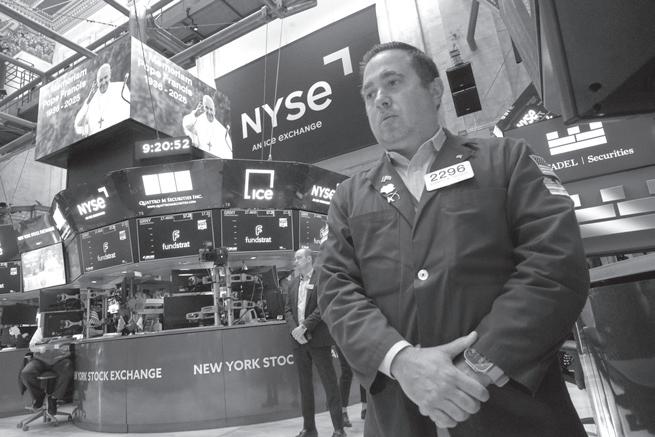

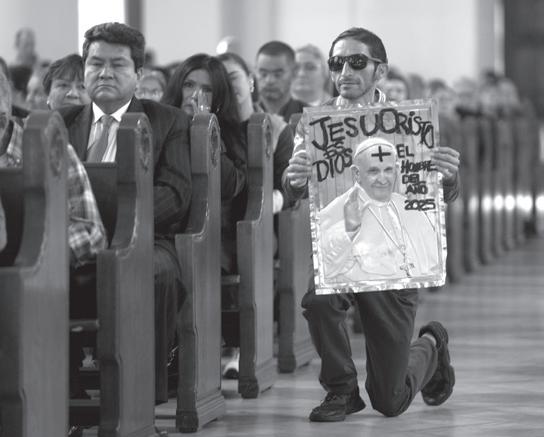















Continued from A1
Though presidents and princes attended the Mass in St. Peter’s Square, prisoners and migrants will welcome him at the basilica across town where he will be buried.
Some 250,000 people flocked to the funeral, held on a brilliant spring day that was supposed to have been a special Holy Year celebration for adolescents. Perhaps because so many young people were on hand, the somber ceremony still had a festive mood, with mourners taking selfies amid the hymns as Francis’s simple wooden coffin was brought out of St. Peter’s Basilica at the start of the Mass.
Cardinal Giovanni Battista Re, the 91-year-old dean of the College of Cardinals, delivered a lengthy, spirited and highly personal homily, or sermon. He eulogized Francis as a pope
of the people, a pastor who knew how to communicate to the “least among us” with an informal, spontaneous style.
“He was a pope among the people, with an open heart towards everyone,” Re said. He drew applause from the crowd when he recounted Francis’s constant concern for migrants, including when he celebrated Mass at the US-Mexico border and travelled to a refugee camp in Lesbos, Greece, and brought 12 migrants home with him.
“The guiding thread of his mission was also the conviction that the church is a home for all, a home with its doors always open,” Re said.
The Argentine pontiff choreographed the funeral himself when he revised and simplified the Vatican’s rites and rituals last year. His aim was to emphasize the pope’s role as a mere


pastor and not “a powerful man of this world.” It was a reflection of Francis’s 12year project to radically reform the papacy, to stress priests as servants and to construct “a poor church for the poor.” He articulated the mission just days after his 2013 election and it explained the name he chose as pope, honoring St. Francis of Assisi “who had the heart of the poor of the world,” according to the official decree of the pope’s life that was placed in his coffin before it was sealed Friday night.
Despite Francis’s focus on the powerless, the powerful were out in force at his funeral. US President Donald Trump and former President Joe Biden, Ukrainian President Volodymyr Zelenskyy, UN SecretaryGeneral António Guterres, and British Prime Minister Keir Starmer joined Prince William and European royals leading more than 160 official delegations. Argentine President Javier Milei had the pride of place given Francis’ nationality, even if the two didn’t particularly get along and the pope alienated many Argentines by never returning home.
Trump and Zelenskyy met privately on the sidelines of the funeral. A photo showed the two men sitting alone, facing one another and hunched over on chairs in St. Peter’s Basilica.
After the Mass, Francis’s coffin left the Vatican en route to his burial place in St. Mary Major Basilica. The white facade of St. Peter’s glowed pink as the sun rose Saturday and hordes of mourners
Editor: Angel R. Calso
April 27, 2025 A3

By John Tozzi
ZEIHEN worried she’d have to file for bankruptcy after learning she owed $250,000 for her Crohn’s disease treatment.
The Milwaukee nursing home worker thought her insurance was covering the infusions as part of a complex arrangement. Through a middleman, her benefit plan was trying to use a charity program to get her the medication for free. But only after months of treatment did Zeihen learn the maneuver backfired, leaving her on the hook for payments.
Zeihen, a cervical cancer survivor, went on to miss weeks of the medication that kept symptoms of her chronic digestive disease in check. She found herself caught in an escalating conflict among US employers, drug companies and insurers over who should bear the skyrocketing costs of prescription drugs.
“This was more stressful than it was actually going through cancer treatment, when I had insurance that covered everything,” Zeihen said. Zeihen’s plight stemmed from a strategy that some US employers are embracing to offset prescription drug costs. Rather than covering expensive medicines on their health plans, they hire outside firms that promise to help patients get supplies of free or subsidized medications that pharmaceutical companies set aside for people who can’t pay. Drugmakers are catching on to these companies, sometimes called “alternative funders,” and are tightening their rules for who can get assistance. That’s increasingly leaving patients contending with unexpected bills for treatments they thought were covered.
“This is a shell game,” said Chris Phillips, a Kentucky rheumatologist who described alternative funders as a “huge issue” for patients. “You have insurance. You think it should pay for your biologic. Now you’re being told there’s no coverage,” he said. “There’s a lot of bumps in the road there and myriad opportunities for patients to drop off treatment.” Alternative funders are one outgrowth of a complex and expensive American healthcare system that strains employers who pay for coverage and patients who rely on it.
Pharmaceutical companies set prices in the private market with few restrictions. Their charity programs help insulate uninsured patients from those prices. That creates an opportunity for middlemen to profit by helping employers try to get supplies of the discounted medications.
When it works, patients get their medicine, employers save money, the middleman gets a fee — and the drugmaker loses a sale. When it doesn’t, people like Zeihen suffer the consequences. It’s a chance many employers seem ready to take.
About 8% of health-benefit plans reported using alternative funding models in a 2024 survey of 157 benefit executives from
Pharmaceutical Strategies Group. Another 13% were exploring the idea, according to the poll, which was sponsored by Roche Holding AG’s Genentech unit.
Zeihen’s plan administrator worked with an alternative funder called Payer Matrix, which has called itself a “thirdparty advocate for patients.”
In a statement, Payer Matrix said it helps patients apply for drugmaker assistance but those programs are “are just one of many solutions the company helps patients navigate” for treatment. The company said it doesn’t charge patients and exists to help them “explore alternative options for low-cost or free medications.” Representatives for Zeihen’s employer, Bedrock Healthcare, and the administrator, Leading Edge Administrators, didn’t respond to repeated requests for comment.
Soaring costs
PRESCRIPTION costs have jumped as new, high-cost therapies reach the market and prices for some older drugs rise. US per capita spending on retail prescription drugs increased 64% between 2013 and 2023 to more than $1,300, according to federal data that isn’t adjusted for inflation. Three-quarters of employers in a survey by the Business Group on Health said they were “very concerned” about pharmacy costs. Patients who need expensive treatments also often face deductibles or co-insurance that drive up their out-of-pocket payments. Drugmakers have long offered subsidies for uninsured patients, and also help defray out-of-pocket costs for insured people with copay cards or other support. Health plans, in turn, develop elaborate programs to maximize how much of that funding they can capture.
That’s where alternative funders come in. If healthplan sponsors remove insurance coverage for certain medications, alternative funders make the case to drugmakers that patients should get the medicines for free or at a discount. Payer Matrix says coverage decisions are entirely
up to the plan, and that it doesn’t decide which drugs are covered.
The maneuvers have come under fire. In April 2024, two members of Congress wrote to the Department of Labor, which oversees employer health plans, with concerns that alternative funders “may mislead employers, exacerbate barriers to patient access” and steer patient assistance funds toward people with insurance.
The representatives, Republican Rick Allen and Democrat Lucy McBath, both from Georgia, called the approach a “predatory practice” and urged the Labor Department to investigate. A department official wrote a letter to McBath in June saying that it was reviewing whether employer arrangements with alternative funders raised compliance issues. It’s unclear, however, whether the issue is being considered under the Trump administration. Representatives for the Labor Department didn’t respond to requests to comment.
‘Hitting walls’ ZEIHEN , 45, encountered the strains first hand.
She was diagnosed in 2022 with Crohn’s disease, an inflammatory bowel disorder that can cause abdominal pain and chronic diarrhea. A drug called Entyvio, from Japanese giant Takeda Pharmaceutical Co., kept her symptoms in check. Out of pocket, without any subsidies, it costs $9,360 a dose, not counting the cost of infusing the medication, according to drug-price data reported by a Texas regulator.
Early in 2024, Zeihen’s health plan began working with Payer Matrix, and she soon found herself in a baffling maze of administrative obstacles. She missed her dose of Entyvio due in January. After weeks of trading phone calls, faxes and messages with Payer Matrix, her clinic, the Entyvio assistance program, and her insurance company, she was approved for treatment and got her dose in February, a month late.
She received her next three doses on time. In September, though, her doctor got a letter saying Zeihen’s pharmacy would no longer give her infusions. The appointment for her October treatment was canceled.
Soon, Zeihen got documents in the mail from the company that runs her health plan saying the doses she’d already received weren’t covered. They indicated that for each visit in April, June and August she owed more than $80,000. Her health plan’s account online showed
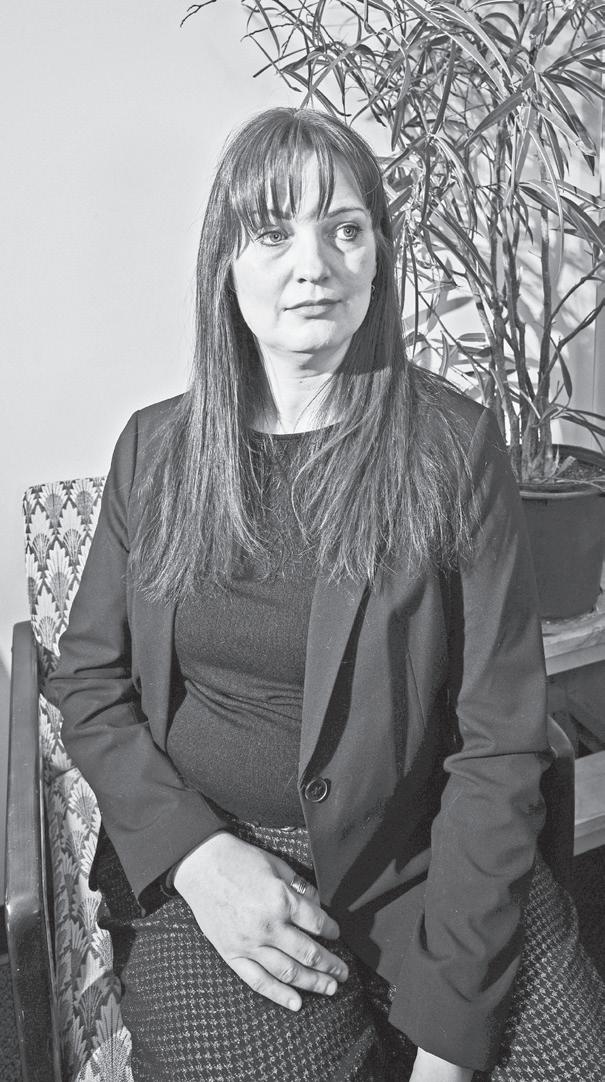
the “amount not covered” as $251,131.73.
“I’m just hitting walls on everything,” she said in an October interview. “In one week, I went from being out of debt to over a quarter of a million in debt.”
She worked with Nilsa Cruz, a patient advocate at Milwaukee Rheumatology Center, to untangle the morass. It was a mess. Zeihen’s insurance card came from Anthem Blue Cross Blue Shield, a subsidiary of Elevance Health Inc. But coverage of the drug ultimately was determined by her employer-funded plan. Leading Edge, the plan’s administrator, had stopped covering Entyvio and relied on Payer Matrix, which was supposed to help get free medication from the manufacturer.
Payer Matrix, based in Media, Pennsylvania, “helps patients access available funding programs for their high-cost specialty drugs,” the company said in a 2023 legal filing. It was founded in 2016, and by 2020 had 100 clients and helped more than 5,000 members get medication, according to its website.
The company has been targeted by a lawsuit from AbbVie Inc. The maker of the blockbuster drug Humira sued Payer Matrix in 2023, alleging it ran “a fraudulent and deceptive scheme to enrich itself” by enrolling “insured patients into a charitable program not intended for them.”
When Payer Matrix gets a patient on the drugmaker assistance program, according to AbbVie’s lawsuit, it charges the employer about 30% of what it saves. “In effect, Payer Matrix is fraudulently obtaining Skyrizi, Rinvoq, and Humira for free from AbbVie and then charging
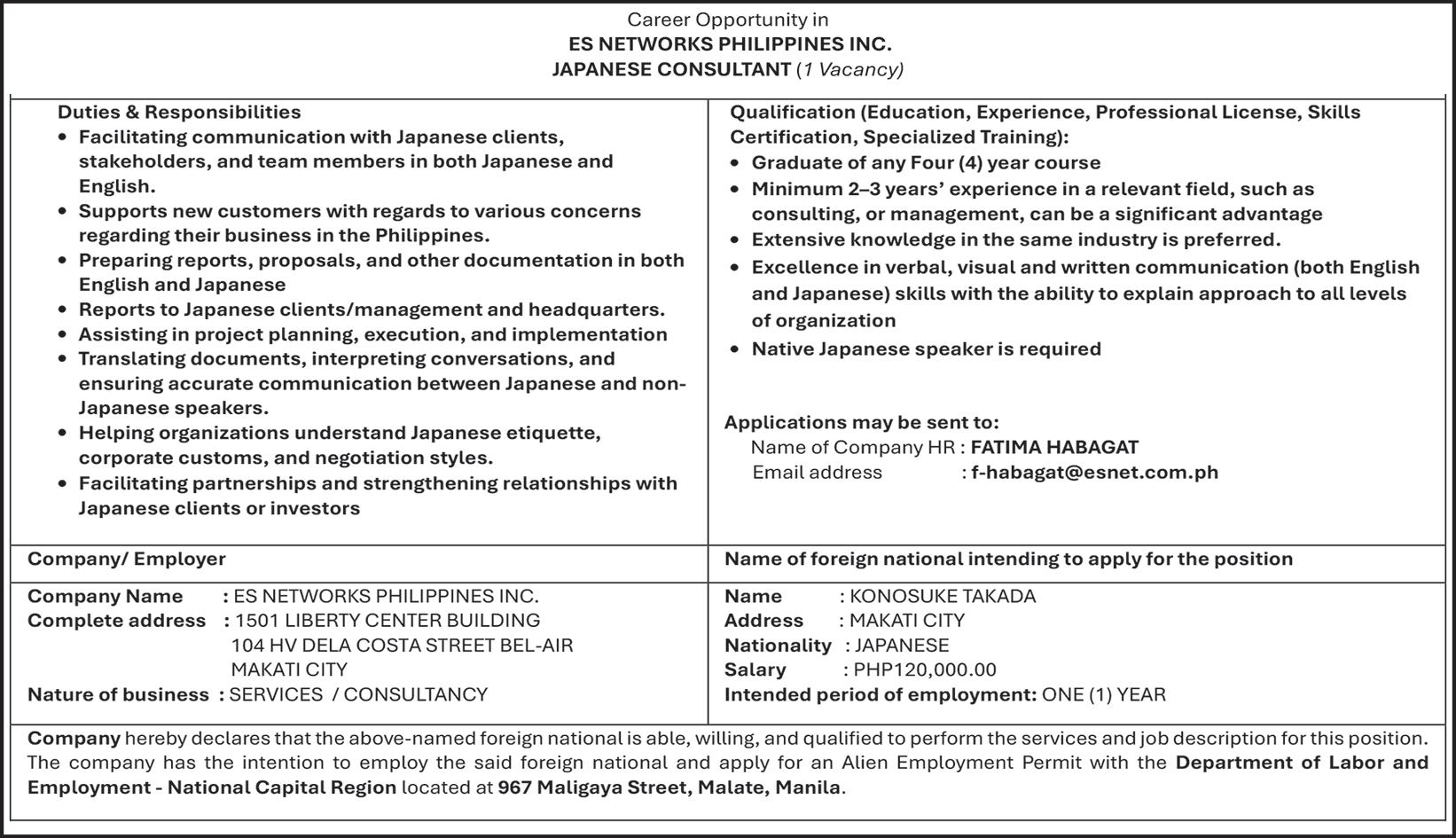
the employers 30 percent of the drug price as its own gain,” the drug giant wrote in its pleading.
Payer Matrix has sought to dismiss the suit, which is pending in Illinois federal court.
In a filing, the company said employers are free to choose whether to cover expensive drugs, and if they exclude them, members must either pay out of pocket or get them through patient assistance programs or other channels. Employers “partner with Payer Matrix to help members navigate what can be a daunting process and to advocate on their behalf,” the company wrote in the filing.
Payer Matrix said in its filing that AbbVie failed to state a claim under consumer protection laws and that a judgement for the drug company wouldn’t benefit consumers.
Some of the statements AbbVie alleged were fraudulent were “puffery,” lawyers for Payer Matrix wrote, arguing that “Payer Matrix’s puffery is not fraudulent.”
Little help STILL , relying on Payer Matrix didn’t work for Zeihen.
“They’re just there to help me sign up for programs I don’t qualify for,” Zeihen said. The company, in its statement, said criteria are determined by the programs and they change frequently. It aims to match patients with programs that fit their circumstances.
In September, Cruz and Zeihen scrambled to get her treatment approved. At the suggestion of Payer Matrix, they applied again to Takeda’s Entyvio assistance program, Cruz said. She didn’t expect the application to be approved, but she hoped a denial would persuade Zeihen’s employer plan to pay for the drug directly.
In its response, Takeda said that Zeihen was ineligible because she was enrolled in an alternative funding program. Takeda declined to comment.
Days before Zeihen’s infusion was due in October, she sent an appeal to Leading Edge and Payer Matrix asking for an exception to cover the drug.
Still, she missed her dose. Cruz emailed the CEOs of Elevance, the company that issued Zeihen’s insurance card, and CVS Health Corp., whose infusion business had treated Zeihen until coverage for the drug was suddenly stopped, as well as Wisconsin Governor Tony Evers. Zeihen said they never heard back.
Cruz flagged what she called “predatory” billing practices in the October 12 e-mail, noting that the $81,000 billed for one dose of Entyvio was far higher than the $6,700 Medicare would pay. She pointed out that Zeihen paid more than $400 a month to be on her employer’s health plan. “And she cannot get care!” she wrote. “Can someone please help this patient?” The coverage remained denied.
Bloomberg News reached out to Elevance on October 25 seeking comment about Zeihen’s story. Three days later, in a message to Cruz, an Elevance representative said the company shouldn’t have authorized Zeihen’s infusions, because coverage of the drug was “carved out” to Payer Matrix, meaning the benefit plan didn’t cover the drug but sent patients to the alternative funder to see if they could qualify for it through different channels.
Elevance apologized for its mistake and agreed to pay the claims, erasing her $250,000 obligation. Elevance also agreed to cover Zeihen’s October treatment, by then weeks late. A representative for the insurer declined to comment further this month.
The payments were a relief to Zeihen. But it didn’t solve her problem for more than a couple of months. She pressed her employer on whether it would offer a plan that covered Entyvio, but she said she couldn’t get one. She said she asked instead if her employer would help her purchase a health plan on the Affordable Care Act marketplace that would cover the drug, but it wouldn’t. So she decided to buy access herself, paying more than $500 a month for a plan with a higher deductible. Her drugs are covered. Bloomberg News

By Ryan J. Foley
The Associated Press
ANSAS CITY, Mo.—In
Kher 28 years working for the federal government, Shea Giagnorio provided day care for the children of US soldiers, training for employees and oversight for safety net programs.
Public service took her from Germany to Alaska to Kansas City, Missouri, where she moved last year for a long-sought promotion.
But when she reported to a downtown federal building for work one day last month, her access card did not work. After a co-worker let her into the building, she checked her e-mail: Her entire office had been let go in the latest mass firing ordered by President Donald Trump’s administration.
The 46-year-old single mom has canceled her apartment lease, is selling her new furniture and may have to pull her daughter out of college.
She wonders what will happen to the at-risk populations her team helped serve at the Administration for Children and Families, a part of the US Department of Health and Human Services.
“Not only me, but all these peoples’ lives are turned upside down,” Giagnorio said.
The impact of the cuts by Trump appointees and Elon Musk’s Department of Government Efficiency can be found everywhere in the Kansas City metropolitan area, which has long been a major hub for federal agencies about 1,000 miles away from Washington, D.C. Money once promised to the region for public health, environmental, diversity, food aid and an array of other programs has been axed, and thousands of local jobs are in jeopardy.
With nearly 30,000 workers, the federal government is the largest employer in the region.
One longtime Kansas City economic researcher said he believes the region could lose 6,000 good-paying federal jobs, which in turn would wipe out thousands of others in service industries.
An IRS worker said thousands of her coworkers fear they will lose their jobs, even as they put in overtime processing tax refunds in a building so crowded that they struggle to find desks. Under pressure, hundreds more agreed this week to retire early or take a buyout.
A US Department of Agriculture grant revocation
disrupted a historically Black neighborhood’s plan to expand its program growing fresh produce in a food desert. A nearby pantry reduced its monthly grocery allotment for those in need after federal cuts left food banks shorthanded.
The withdrawal of federal funding for new lab equipment and vaccines means the city may be less prepared for the next pandemic.
A landlord may have to sell an office building for a loss after his federal tenants were among several that abruptly canceled local leases, adding a glut of real estate to the market.
And the city’s Tesla showroom has become a spot of weekly protest. Activists are seeking to have it closed by pushing a referendum intended to drive Musk’s electric car company out of Missouri.
HHS: Cuts to service for lowincome families
THE nation’s health department is slashing its full-time national workforce from 82,000 to 62,000. Among them were Giagnorio and her colleagues in her agency’s 10 regional offices around the country that helped deliver services through programs such as Head Start and emergency assistance for lowincome families.
“The poor will become even poorer now,” Giagnorio said. “If we’re taking away social safety nets, what is the end result? If we’re not helping homeless people anymore, will they freeze to death in the winter? Is that what we want?”
Giagnorio, who spent most of her career as a US Department of Defense civilian employee at bases in Germany and Alaska, is on paid leave until her June 2 termination. She wasted no time looking for another position after being locked out of her office, visiting a job fair hours later that Kansas City hosted for displaced federal workers.
But she doubts she will be able to find a public sector salary anywhere near the $117,000 she made and doesn’t know how her skills translate to the private sector. She worries about losing the health insurance that covers her family and having to pull her daughter out of Maastricht University in the Netherlands after her first year. For now, she can’t get any answers from the agency to basic questions about her financial future. Does she still qualify for an early retirement buyout offer that had been extended?
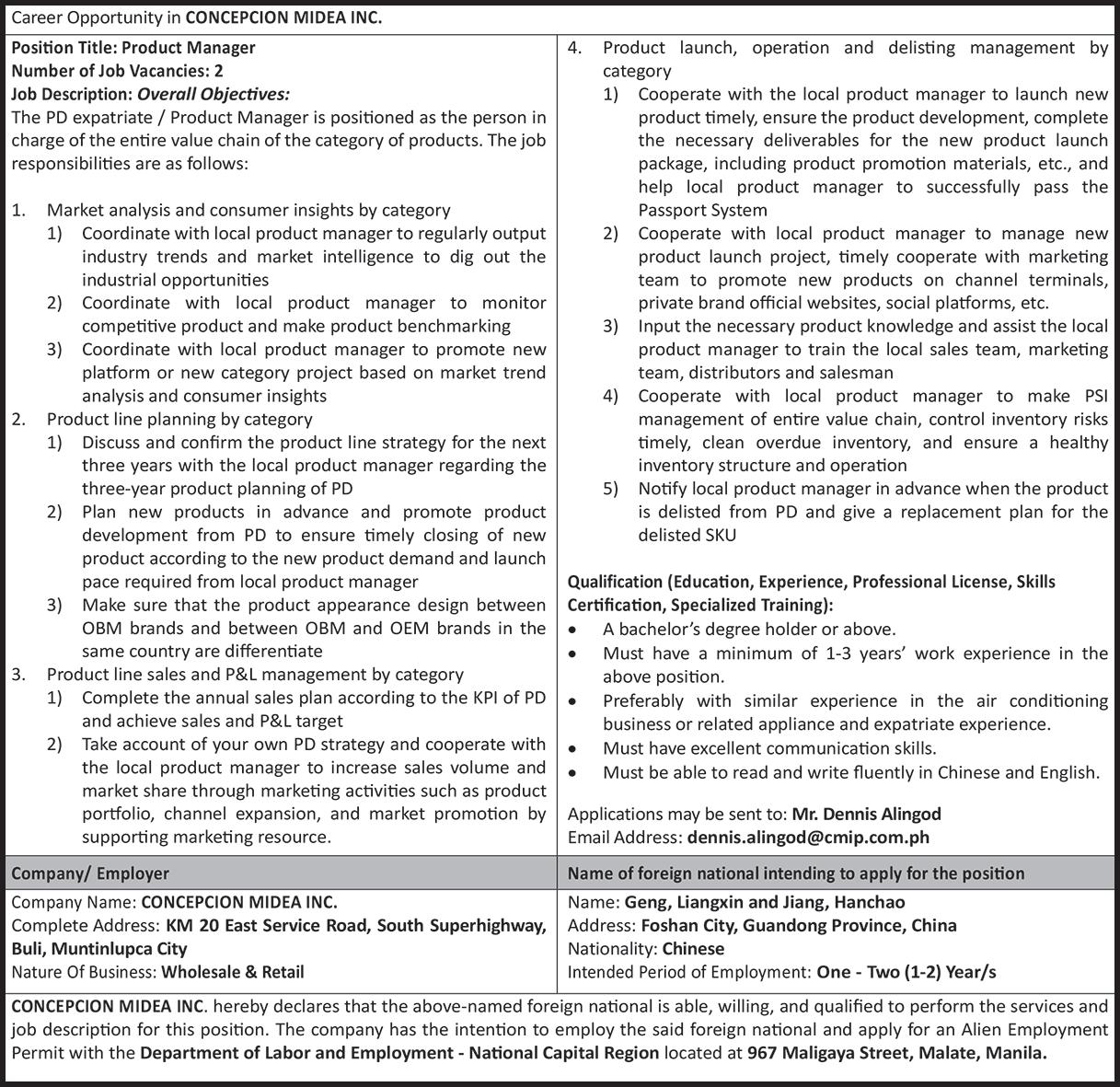
How much would she receive and when?
IRS: A rush to Tax Day, then layoffs and buyouts
T HE days leading up to the April 15 tax filing deadline were always going to be busy for workers at the IRS processing center near Union Station, but this year, they were particularly stressful.
The IRS is considering a downsizing that could cut as many as 20,000 employees, or 25% of its workforce, in the coming weeks. The roughly 6,000 employees in Kansas City faced agonizing choices: decide whether to accept resignation or early retirement offers by April 14 or risk losing their jobs later.
“It’s a kick in the stomach to people that are doing everything they can to meet what’s required of them,” said Shannon Ellis, a longtime IRS customer service representative and president of the union representing local workers.
By Thursday, at least 238 Kansas City workers had taken the buyout offers and were expected to leave the agency in coming weeks. Ellis noted many of those same workers had been told they were essential and required to work overtime during tax season, some seven days per week.
Their building has been overcrowded since the IRS ordered remote employees back to the office in March. Workers sometimes struggle to find open desks. Some have to bring their own ink pens and share date stamps to perform basic job functions after budget cuts have depleted supplies.
Ellis said IRS workers share the public’s disdain for taxes but understand that collecting them is necessary to support important programs like Social Security. She said she’s decided to take a “roll of the dice” and stay in her job, spurning an early retirement offer.
“I love my job,” she said. “I’m not going to let the bully force me out.”
USDA: An urban food desert loses help
URBAN farmer Rosie Warren grew 2,500 pounds of fruits and vegetables last year in community gardens to help feed the Ivanhoe neighborhood, where many Black families were concentrated under housing segregation policies of much of the 20th century.
Warren harvested greens, potatoes and watermelons as
part of an effort to address food insecurity and health concerns in a neighborhood challenged by blight, crime and poverty. She was ecstatic last fall when the USDA awarded the neighborhood council a three-year, $130,000 grant to expand the gardens and farmers’ market serving the area.
Plans called for hiring an assistant to help Warren with growing more food and to add another market day aimed at serving more low-income older adults, mothers and children.
In February, the council received a notice terminating the grant. The USDA had determined the award “no longer effectuates agency priorities regarding diversity, equity, and inclusion programs and activities.”
On a recent morning, Warren took a break from preparing the soil for planting to ponder the USDA’s decision.
“What do you do if you don’t support providing access to food to people who don’t have it? Wouldn’t this make your job easier?” she said. “I think it’s absurd. It doesn’t make any sense.”
Other food aid in the neighborhood has taken a hit at a time when demand is rising.
At the Bishop Sullivan Center food pantry, hundreds of lowincome families are getting fewer groceries in their monthly pickups after USDA halted $500 million worth of deliveries to food banks. That included a planned order for 41,000 cases of meat, dairy and other commodities to a bank serving Kansas City.
“It just means giving families less food,” said pantry director Christopher Lowrance, who said he’s able to provide less chicken and other meat products. “It’s as simple as that.”
Public health: The city lab misses a needed upgrade
THE Kansas City Health Department’s laboratory is badly in need of an upgrade, with equipment dating to when the building opened in the 1990s.
One basement space is water damaged and rarely used.
Another has equipment that is so inadequate that the city has to ship samples to a state laboratory 150 miles away, causing inefficiencies, agonizing waits for results and delayed response times.
Kansas City’s health director, Dr. Marvia Jones, made it a top priority to modernize the labs this year after studying their response to the Covid-19

pandemic. Her agency planned to use federal funding to purchase new microscopes and testing equipment.
“That early disease detection allows you to do more rapid intervention, more rapid treatment, more rapid isolation,” she said.
But the funding for lab upgrades was abruptly eliminated last month as part of the Trump administration’s $11.4 billion cancellation of federal grants to states for public health. That news “crushed” the department’s carefully laid plans, Jones said.
Jones said the cuts, $3 million and counting for her department, mean the city will also have fewer vaccines to administer to low-income residents.
“It would be a sad shame for us to be in a worse position than we were before the pandemic,” she said. “We had processed all of our lessons learned, and then now this happens.”
Real estate: A landlord considers selling his building AMIR MINOOFAR was surprised when two federal agencies notified him that they planned to vacate the office building he’s owned for a decade in Overland Park, Kansas, a suburb of Kansas City.
Minoofar said the Occupational Safety and Health Administration had recently agreed to extend its lease until 2029. The National Labor Relations Board, meanwhile, was paying month to month.
Minoofar said the government initially notified him the agencies would be out of the building in August, part of a DOGE-led blitz of hundreds of lease cancellations that has been marked by errors and subsequent reversals.
In the Kansas City metropolitan area, the government is moving to cancel 10 leases totaling 219,000 square feet that cost more than $4 million in annual rent, according to DOGE’s online “Wall of Receipts.”
Minoofar said he was more recently told the agencies will likely have to stay past August and their departure date is now unclear. He said he may have to sell the building, which has an appraised value of $2.9 million, and take a loss because of the difficult office market.
But he said he understands why the government would unload the space, which he said has often been sparsely used since the rise of telework during the pandemic.
“Businesswise, it makes sense for government to cut costs,” he said. “A lot of people are going to be unhappy but it’s a huge gigantic family and they need to take care of it. You cannot keep everybody happy.”
Tesla: Elon Musk’s car company faces a statewide campaign
With liberal anger growing at Musk’s role in the government, protesters have gathered Saturdays outside his Tesla dealership in Kansas City to denounce the cuts.
State records show Tesla sales there have dropped amid calls for a boycott. Now, enough voter anger could even force the business to close.
Organizers of a newly launched “Unplug Musk”
initiative are seeking to use democracy to strike at the world’s richest man by changing state law to ban car manufacturers from selling directly to consumers.
They say they plan to soon begin gathering the 111,000 signatures of registered voters that they would need to put the change on the statewide ballot in November 2026. If approved by voters, it would force the closure of the Tesla showrooms in Kansas City and St. Louis.
Missouri’s governor, Republican Mike Kehoe, a former auto dealer himself, sponsored a 2014 bill when he was a state senator aimed at requiring manufacturers like Tesla to sell through local dealers. The bill passed the Senate but died in the House after Tesla lobbied against it. The referendum revives that plan.
“There’s not a soul in this country who’s against trying to weed out government inefficiency but just taking a chain saw to people’s lives and their health care is a ridiculous way to achieve that. And it is going to cause some devastating impacts,” said organizer Brad Ketcher, a prominent Democrat and lawyer who helped draft the state’s 2022 marijuana legalization referendum.
The administration’s response: Temporary hardship
AN HHS spokesperson said the agency’s downsizing, including cutting jobs and consolidating divisions, would save money and make the organization more efficient. As for the $11.4 billion in grant funding cuts, the spokesperson said, “HHS will no longer waste billions of taxpayer dollars responding to a nonexistent pandemic that Americans moved on from years ago.”
The IRS has offered a similar rationale for its downsizing, saying it is making process improvements that will ultimately more efficiently serve the public.
Musk said last year that Trump’s budget cuts would cause a “temporary hardship” that would soon put the economy on stronger footing.
One local economic researcher said it remained unclear just how deep that hardship will be in Kansas City, including whether it will just slow growth or cause population losses.
“It’s a big burden that’s being placed on a narrow group of people,” said Frank Lenk, director of the Office of Economic Development at the Mid-America Regional Council, a nonprofit of city and county governments in the Kansas City region. “It will definitely take some of the steam out of the local economy.”
Trump has credited DOGE with helping end “the flagrant waste of taxpayer dollars,” saving billions to help improve the nation’s finances.
The White House didn’t respond to questions about Kansas City. But Trump said recently he would invite the Kansas City Chiefs to the White House to make up for a 2020 Super Bowl victory celebration that was canceled during the pandemic.
The Associated Press writer Heather Hollingsworth contributed to this report.

By John Eiron R. Francisco
TO strengthen space science education and foster international cooperation, the Philippine Space Agency (PhilSA) and the Italian Embassy in the Philippines, through the Italian Space Agency, launched their first joint exhibit at the University of the Philippines National Institute for Science and Mathematics Education Development (UP Nismed) on April 23.
“This exhibit is a good start, because it’s a collaboration where we bring our capabilities so far,” said PhilSA Director General Dr. Joel Joseph Marciano Jr. in an interview with BusinessMirror.
Marciano noted that while Italy has long been active in space exploration, the Philippines is steadily building momentum in the field.
“We’re beginning, but we are gaining strength,” he said. He emphasized that the exhibit presents the current state of both countries’ space ecosystems and, more importantly, explores how these can be brought together for shared growth and mutual benefit—through academic and scientific collaboration, as well as industrial joint ventures.
The Italian Ambassador to the Philippines Davide Giglio, also speaking with BusinessMirror, expressed optimism about the partnership, citing a shared commitment between the two nations’ space agencies.
He described the exhibit as a starting point for a “cosmic journey” and a promising step toward deeper regional and international cooperation.
“I’m sure this event will be a powerful catalyst for regional, international, and bilateral cooperation. We started this voyage together, and I’m really happy about this,” the ambassador said.
The exhibit, “Cosmic Journeys: Celebrating Philippines and Italy in Space,” highlights the collaborative efforts of the Philippines and Italy in advancing space science, featuring two special showcases that reflect both countries’ shared
passion for space exploration.
Running from April 24 to May 2 (excluding weekends and holidays), the exhibit is open from 9 a.m. to 5 p.m. at the UP Nismed. It features “From Moon to Mars: Italy in Space Exploration,” and “#YamangKalawakan: The Philippine Space Ecosystem,” displayed at the Ground Floor Lobby of UP Nismed.
Towards a space-faring PH MARCIANO further explained that for the Philippines to become a truly space-faring nation, it must be capable of operating and managing its own satellites. Achieving that vision, he added, requires building a strong local space industry.
Part of the Philippines’ longterm vision, he added, is to strengthen what PhilSA refers to as “Yamang Kalawakan” (Space Wealth)—a term that symbolizes the country’s collective space resources, including its people, institutions, policies, capabilities, and enabling environment.
“If you look at the space agency now, we’re 240 people—young engineers and scientists mostly in their late 20s,” Marciano said. “We’ve distributed around 60,000 maps to various institutions and logged over 140,000 person-hours of training to build capacity across the country.”
He emphasized that the country’s space agency is not only focused on downstream applications like mapping and training, but is also building upstream competencies in technologies that actually go to space.
Among its current flagship
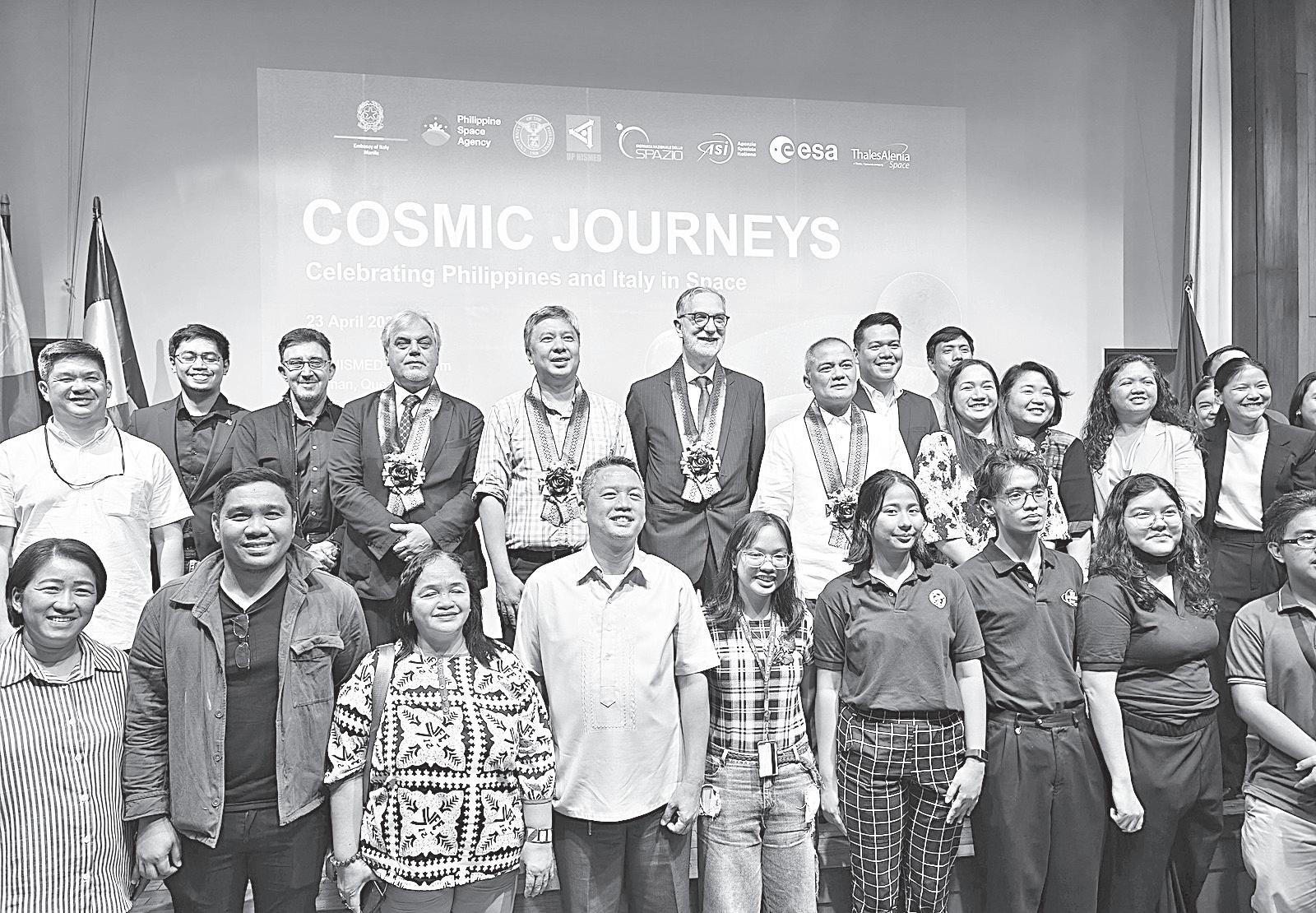
initiatives is the development of a multispectral satellite unit for land assessment, which is scheduled for deployment in 2026.
“What’s important here is that we have a license to remanufacture the satellite in-country,” Marciano said. “This means local Filipino companies can be involved in the next build, helping transition their expertise from producing earthbound components to spacequalified systems.”
Marciano believes this is a key step in building a sustainable and vibrant local space industry, one that can meaningfully contribute to and benefit from the global space economy.
“It opens doors for creating a space industrial base here in the Philippines,” he said.
He added that partnerships with Italian companies could play a crucial role in creating joint ventures with Filipino firms and in opening opportunities to strengthen the country’s broader space ecosystem.
Giglio echoed this sentiment, assuring that the Italian embassy is ready to support local initiatives and help facilitate linkages between the Philippine space ecosystem and Italian firms.
“Please count on the help that the Italian embassy can offer,” he said, noting the benefits these partnerships can bring to both countries and the global community.
‘Boosting space economy’
MEANWHILE , Marciano outlined several ways the space sector can contribute to the country’s eco -
nomic growth, beginning with what he described as the “upstream” side of the industry.
He pointed to existing Philippine industries—such as semiconductors, electronics, machining, and renewable energy—as having significant potential to support space technology development.
Components produced by these sectors, including solar panels, wiring, and electronic parts commonly used in automotive applications, he added, can also be adapted for use in satellite systems and other space-bound technologies, he said.
“These technologies only need to be tested for the space environment,” Marciano noted, emphasizing that efforts are underway to develop a domestic industry capable of producing more complex, space-qualified products. These, he added, would carry not just a “Philippine brand” but also reflect Filipino ingenuity.
The PhilSA chief also expressed support for legislative measures like the Tatak Pinoy Act and initiatives that promote self-reliance in defense technologies.
According to Marciano, space technologies and local industries can significantly contribute to such national efforts.
On the “downstream” side, the country can tap into its growing capabilities in satellite data processing and operations. By extracting value from imagery— whether from Philippine satellites or those of other nations—the country can produce tools like agricultural maps, maritime domain awareness systems, and disaster

preparedness resources.
“These applications have direct implications on productivity, livelihoods, and the broader economy,” he said.
Moreover, Giglio underscored the long-term significance of investing in science and research, emphasizing its crucial role in driving innovation and sustainable progress over time.
“It’s proved by history that when you invest into science, into research, you may not immediately have a return, but over the years, any big innovation has been fostered by research and development investments made years before,” Giglio said.
While acknowledging that the exact outcomes of current financial commitments are difficult to predict, the ambassador noted that “they are bound to happen,” citing historical and economic evidence of R&D’s lasting impact.
He pointed out the importance of both government and private sector involvement in advancing scientific progress.
Giglio noted that Italy benefits from the presence of major companies heavily involved in the space sector, with their investments complementing state-funded research.
He added that while the Philippines may be operating on a different scale, it is actively forging connections with international players—particularly European partners like Italy and the European Space Agency (ESA)—within programs such as the EU’s Copernicus initiative.
“Investing together in space, into research and development, is critical for the advancement of both societies,” he said. “And it’s important that we share experiences and best practices so that we can find some common ground and a credible and shared roadmap into the future.”
PHL-Italy space ties lift off with forum, expo collabs THE Italian envoy revealed that PhilSA has been invited to participate in the upcoming space-related events in Japan, particularly at the Osaka Expo where Italy will showcase its initiatives. Among these is a space-focused program scheduled for May.
Additionally, Giglio said that the Philippines is set to host the International Space Forum this December—an event spearheaded by the Italian Space Agency for over a decade.
Previously held in regions such as Africa, the Middle East, Latin America, and Europe, this marks the first time the forum will take place in Southeast Asia. Giglio confirmed that PhilSA has expressed its readiness to host the event, emphasizing its potential to strengthen inter-regional collaboration between Asean and European space partners, and to further deepen bilateral ties between the Philippine and Italian space agencies.
“This is certainly a major opportunity,” he said, noting that it will also be the first time an Asean country will serve as host for the forum. “We’re very glad that it’s happening here in the Philippines,” he said.
BANANAS are one of the most consumed agricultural products in the country. The Philippine Statistics Authority (PSA) reported that banana production was estimated at 2.29 million metric tons from April to June 2023, an annual increase of 0.1 percent from the same period in 2022.
Among the 20 known varieties of banana in the Philippines, the Cavendish, is the most common and widely cultivated, with the highest production of 1.17 million metric tons in 2023 alone, accounting for 51.5 percent of the total banana production.
However, despite the high production, banana growers are experiencing challenges due to certain plant diseases or wilt, which cause significant losses.
According to the Department of Science and Technology’s Philippine Council for Agriculture, Aquatic, and Natural Resources Research and Development (DOSTPCAARRD), the banana industry’s major problem is its susceptibility to diseases—such as banana bunchy top disease
(BBTD), Sigatoka, and Fusarium wilt, also known as Panama disease.
In an episode of ExperTalk aired via the DOSTv, the Hijo Resources Corp., one of the top banana producers in the Davao region, said that banana wilt affects around 3 percent to 5 percent of their total productivity.
Fusarium wilt is a soilborne fungal disease caused by the fungus called Fusarium oxysporum that damages plants’ vascular systems, leading to wilting, yellowing, and eventual death.
“Fusarium wilt is a plant disease which came from a fungus called Fusarium. It attacks different types of plants, however, there is a specific strain that attacks bananas. This is what we call Fusarium oxysporum f. sp. cubense, which can affect all types of bananas,” said Dr. Merlina H. Juruena, research director at the University of the Southeastern Philippines (USEP).
“The fungus Fusarium oxysporum f. sp. cubense [FOC]—as a soil-borne

fungus—have the ability to stay alive despite the banana being out of the soil. It is because this fungus has a structure called Chlamydospores,” she added.
Juruena explained that when the fungus runs out of food in the banana, which become their home and source of nutrients, the fungus will automatically form a resting structure called Chlamydospores.
Chlamydospores are structures that allow the pathogens to survive in
unfavorable conditions. For example, even if it is exposed to the sun or soaked in water, the fungus will remain alive. Not even the ordinary chemicals used in plantations can fight it. However, despite being infected with FOC, Juruena clarified that bananas are still safe to eat because it has no direct effect on the nutrient content of banana fruit, and most importantly, the disease cannot be transmitted to humans.
Meanwhile, if the infection
continues, the method of planting Cavendish bananas will be affected. With no seeds that can be planted, the only way to produce it is to regrow the shoots of the Cavendish variety.
To address this problem, researchers from the USEP are exploring solutions to lessen the harmful effect of FOC, targeting bananas.
“It causes blockage to the vascular vessel. Prior to that, the FOC infects bananas through fine root hairs. It stays in the vascular bundle, in the pseudostem,” plant pathologist Vladimir Ivan Dodongan said, explaining how fungus attacks bananas.
The vascular vessels of a plant are important for transporting water and nutrients.
In his study, Dodongan explored the effectiveness of Trichoderma harzianum, a fungus that is known as a biological control agent used to control the population of pests and pathogens in plants.
“The result is less manifestation, or the severity of the disease. There is still
yellowing, but not as severe as compared to the uninoculated or untreated with Trichoderma harzianum,” Dodongan said.
On the other hand, Johanna Roselle Salvar, also a plant pathologist from USEP, is testing if bacterial endophytes from the roots of a healthy banana plant can fight the fungus of an infected Cavendish plant.
“I found out that bacterial endophytes from the healthy banana roots have potential both in laboratory conditions and greenhouse conditions. The result is it lessens the severity of the Fusarium [wilt],” Salvar said.
Dodongan and Salvar are still working to improve their studies. If proven effective, these solutions may be helpful for banana growers in managing plant diseases like Fusarium wilt.
Acknowledging the importance of these inventions, USEP encourages the next generation of experts to
into
of
pathology and explore their potential in this field.
A6 Sunday, April 27, 2025 Editor: Lyn Resurreccion •

By Nicole Winfield
VATICAN CITY—Few moments in Pope Francis’ papacy better exemplify his understanding of climate change and the need to address it than the rain-soaked Mass he celebrated in Tacloban, Philippines, in 2015.
Wearing one of the cheap plastic yellow ponchos that were handed out to the faithful, Francis experienced first-hand the type of freak, extreme storms that scientists blame on global warming and are increasingly striking vulnerable, low-lying islands.
He had traveled to Tacloban, on the island of Leyte, to comfort survivors of one of the strongest recorded tropical cyclones, Supertyphoon Yolanda (international code Typhoon Haiyan).
The 2013 storm killed more than 7,300 people, flattened villages and displaced about 5 million residents.
But with another storm approaching Tacloban two years later, Francis had to cut short his visit to get off the island.
“So many of you have lost everything. I don’t know what to tell you,” Francis told the crowd in Tacloban’s muddy airport field as the wind nearly toppled candlesticks on the altar.
Francis, who died April 21 at 88, was moved to silence that day by the survivors’ pain and the devastation he saw. But he would channel it a few months later when he published his landmark encyclical, “Praised Be,” which cast care for the planet as an urgent and existential moral concern.
The first ecological encyclical THE document, written to inspire global negotiators at the 2015 Paris climate talks, accused the “structurally perverse,” profitdriven economy of the global north of ravaging Earth and turning it into a “pile of filth.”
The poor, Indigenous peoples and islanders like those in Tacloban suffered the most, he argued, bearing the brunt of increasing droughts, extreme storms, deforestation and pollution.
It was the first ecological encyclical, and it affirmed the Argentine Jesuit, who in his youth studied to be a chemist, as an authoritative voice in the environmental movement.
Later cited by presidents and scientists, the document inspired a global faith-based coalition to try to save God’s creation before it was too late.
“I think he understood from the beginning that there are three relationships that had to be regenerated: Our relationship with God, our relationship with the created world and our relationship with our fellow creatures,” said papal biographer Austen Ivereigh. It wasn’t always so.
A conversion in 2007 in Brazil FRANCIS had a steep learning

POPE Francis’ tomb in the Basilica of St. Mary Major has been made with materials from the Italian region of Liguria. It is a simple tomb bearing only the inscription “Franciscus” and a reproduction of the late Pope’s pectoral cross. The tomb is located near the Altar of St Francis, in the niche of the side nave between the Pauline Chapel (Salus Populi Romani Chapel) and the Sforza Chapel. Speaking on television, the co-Archpriest of the Basilica, Cardinal Rolandas Makrickas, announced Pope Francis’ desire to be buried in a tomb made from the “stone of Liguria, the land of his grandparents.”
From Italy to Argentina
IT is precisely in the small town of Cogorno that a plaque of slate—a
fine-grained grey, green or bluish metamorphic rock—commemorates Bergoglio’s great grandfather, Vincenzo Sivori. He travelled from Italy to Argentina in the 1800s. There, he raised his family, including his grandaughter Regina Maria Sivori: Pope Francis’ mother.
“A great gift; one last surprise” POPE Francis often kept his connection to Liguria private, so the mayor of the town, Enrica Sommariva, described her surprise when she heard that the pope had requested stone from his grandparents’ region for his tomb. Angela Sivori, who still lives in Cogorno, recounted the moment in which she found out she was Pope Francis’ cousin.
She described receiving a phone call from Buenos Aires,
curve on the environment, just as he did with clergy sexual abuse, which he initially dismissed as overblown. He himself pointed to a 2007 meeting of Latin American and Caribbean bishops in Aparecida, Brazil, as the moment of his ecological awakening.
There, the then-Cardinal Jorge Mario Bergoglio had been elected to draft the conference’s final document, and was under pressure to include calls from Brazilian bishops to highlight the plight of the Amazon.
Bergoglio, the dour-faced archbishop of urbane Buenos Aires, didn’t get what all the fuss was about.
“At first I was a bit annoyed,” Francis wrote in the 2020 book “Let Us Dream.” “It struck me as excessive.”
By the end of the meeting, Bergoglio was converted and convinced.
The final Aparecida document devoted several sections to the environment: It denounced multinational extraction companies that plundered the region’s resources at the expense of the poor. It warned of melting glaciers and the effects of lost biodiversity. It cast the ravaging of the planet as an assault on God’s divine plan that violated the biblical imperative to “cultivate and care” for creation.
Those same issues would later find prominence in “Praised Be,” which took its name from the repeated first line of the “Canticle of the Creatures,” one of the bestknown poetic songs of the pontiff’s nature-loving namesake, St. Francis of Assisi.
They also would be highlighted in the Amazon Synod that Francis called at the Vatican in 2019, a meeting of bishops and Indigenous peoples specifically to address how the Catholic Church
and a genealogy tree via email. She and her daughter, Cristina, said the pope’s request regarding the stone for the tomb was a wonderful gift to the family, “one last surprise.”
Meeting the families
In May 2017, Pope Francis met his family in Genova.
Cristina recalled that at the time her mother was 87 and that they had no idea they would be meeting Pope Francis until the very last minute.
“Then, three days before, we got a call from the Vatican. Seven of us got together and he welcomed us like a cousin who had come from the ‘end of the world.’”
During the meeting, Pope Francis shook his cousins’ hands, smiled, and exclaimed, “At last, I meet the Sivoris!”
The people’s stone SO there is a deep connection between slate and the late pope.
Franca Garbaino, the president of the Slate District, which includes 18 quarries and 12 companies in the Ligurian hills, described it as “not a noble stone” but rather as “the people’s stone”, and one that “gives warmth.” The district has already agreed to create slabs that will accompany Pope Francis in his eternal rest.
Even before the pope, the town of Cogorno had ties to Popes Innocent IV and Adrian V.
The town, carrying this pleasant surprise, echoes how Pope Francis lived, up until the very end of his earthly journey.
Edoardo Giribaldi/Vatican News

could and should respond to the plight of the Amazon and its impoverished people.
“I think the pope’s most important contribution was to insist on the ethical aspect of the debate about climate justice,” said Giuseppe Onofrio, head of Greenpeace Italy, “that the poor were those who contributed the least to pollution and the climate crisis, but were paying the highest price.”
How the environment affects all other ills
IN many ways, those same issues would also come to define much of Francis’ papacy.
He came to view the environmental cause as encapsulating nearly all the other ills afflicting humanity in the 21st century: poverty, social and economic injustice, migration and what he called the “throwaway culture”—a melting pot of problems that he was convinced could only be addressed holistically.
Some of Francis’ strongest calls to protect the environment would come on or around Earth Day, celebrated April 22.
“For some time now, we have been becoming more aware that nature deserves to be protected, even if only because human interaction with God’s biodiversity must take care with utmost care and respect,” Francis said in a video message released on Earth Day in 2021.
Cardinal Michael Czerny, the Canadian Jesuit whom Francis would later entrust with the ecological dossier, said the 2007 meeting in Brazil had a big impact on Francis.
“In Aparecida, listening to so many different bishops talking about what was deteriorating, but also what the people were suffering, I think really impressed him,” said Czerny.
Czerny’s mandate encapsulated Francis’ vision of “integral ecology,” covering the environment, the Vatican’s response to the Covid-19 pandemic, its charitable Caritas federation, migration advocacy, economic development and its antinuclear campaign.
The multifaceted approach was intentional, Czerny said, to establish new thinking about ecology
that went beyond the politicized concept of “green” advocacy to something bigger and nonnegotiable: humanity’s relationship with God and creation.
“Everything is connected,” Francis liked to say.
A legacy from Pope Paul VI HE was by no means the first pope to embrace the ecological cause. According to the book “The Popes and Ecology,” Pope Paul VI was the first pontiff to refer to an “ecological catastrophe” in a 1970 speech to a UN food agency. St. John Paul II largely ignored the environment, though he did write the first truly ecological manifesto: his 1990 World Day of Peace message, which linked consumer lifestyle with environmental decay.
Pope Benedict XVI was known as the “green pope,” primarily for having installed solar panels on the Vatican auditorium and starting a tree-planting campaign to offset the greenhouse gas emissions of Vatican City.
Francis issued an update to “Praised Be” in 2023, just before the UN climate conference in Dubai. While consistent with the original text, the update was even more dire and showed Francis had grown more urgent in his alarm. He became even more willing to point fingers at the world’s biggest emitters of heat-trapping greenhouse gases, especially the US. And he called out those, including in the church, who denied the human causes of global warming.
“He showed that he had an understanding of what was happening in the world, and he saw the world from the point of view, as he was like to say, of the peripheries, of the margins,” said Ivereigh, the papal biographer. “He brought the margins into the center.” AP
‘WHO’S your favorite saint?” a young girl asked Pope Francis in February 2016 during the preparation of the interview book “From the Poor to the Pope, from the Pope to the World” (Seuil, April 2022).
His answer touched many hearts, especially in Normandy region, wrote Anne Blanchard in “Ouest-France,” a daily French newspaper.
“I’m a friend of Thérèse of the Child Jesus. Go into my room and you’ll see— you’ll find many reminders of little Thérèse there,” the pope replied. St. Thérèse’s birthplace, Lisieux, is a town in Normandy in northern France.
Little Thérèse always with him BLANCHARD wrote that journalist Élisabeth de Baudouïn reports in her book “Thérèse and Francis” (Salvator, 2019) that from the moment of his election, Pope Francis showed his devotion.
Returning from Rio de Janeiro in 2013, one of the journalists on the papal flight asked what was inside the small black bag the Pope always carried.
Francis replied, “There’s a razor, my breviary, my calendar, a book to read...I brought a book about little Thérèse. I’m devoted to her.”
Blanchard added that de Baudouïn wrote that the pope has been entrusted with relics of the Norman saint and often tucks holy cards of Thérèse dressed as Joan of Arc into letters he sends to cardinals.
“Thérèse is direct and effective,” he once told a Malagasy bishop, encouraging him to pray for his diocese. “She uses simple, more-than-ordinary means to accomplish extraordinary things.”
According to the journalist, Jorge Mario Bergoglio regularly prayed the Rose Novena to the saint who promised to send a shower of roses upon the earth after her
entrance into eternal life. And indeed, he frequently received white roses—seen as signs of Saint Thérèse’s loving intercession, Blanchard said.
A rose in Saint Peter’s Square ON June 7, 2023, before thousands gathered in Saint Peter’s Square for the weekly general audience, Pope Francis paused in prayer holding a white rose, the “Ouest-France” story added.
In a rare gesture, the Shrine of Lisieux had brought the centenary reliquary of Saint Thérèse of the Child Jesus to Rome at the pope’s request. The moment was all the more poignant because the Holy Father had been hospitalized the night before at Gemelli Clinic.
Despite this, he insisted on holding the audience and praying beside the relics.
(In a rare exception, the transparent cover protecting the reliquary was removed.) That same afternoon, he underwent emergency surgery for a risk of intestinal blockage, the news report said.
A bouquet of graces
BUT why a white rose? In their interview book, Jesuit Sergio Rubin and Francesca Ambrogetti asked this question when, years earlier, they noticed a vase of white roses in front of a photo of Thérèse on then-Cardinal Bergoglio’s desk.
He explained: “When I have a problem, I don’t ask Saint Thérèse to fix it, but to take it in hand and help me accept it. And as a sign, almost always receive a white rose.”
That’s why the general audience on June 7, 2023—in the presence of the relics of Saint Thérèse of Lisieux and her saintly parents, Louis and Zélie Martin—held such unique significance. The gathering was part of the dual jubilee marking the 150th anniversary of Thérèse’s birth and the 100th anniversary of her beatification.
During his homily, the Pope announced he would dedicate an apostolic letter to her, to be released in October 2023. Fr. Olivier Ruffray, then administrator (and former rector for a decade) of the Sanctuary of Lisieux, came to Rome with a delegation from Normandy—including the mayor of Lisieux and the president of the Lisieux Normandie region—to renew the invitation for the Pope to visit Lisieux. Pope Francis had already planned a trip to Marseille for September 23, 2023.
Fr. Ruffray commented with hope and trust: “If Thérèse and the Pope wish to meet, they will find the time, the place, and the right moment.”
A pope close to Carmel MEANWHILE, the Order of Discalced Carmelites nuns in a convent in Valencia, Spain, “wish to remember him with special gratitude.”
“Throughout his pontificate, Pope Francis showed heartfelt affection toward our family. He accompanied us with profound words, with simple gestures, and with a closeness we will not forget,” they said in a blog post on http://carmelopuzol.org/.
On the the fifth centenary of the birth of Saint Teresa of Jesus in 2015, the pope wrote two letters: one to the Order and another to the bishop of Ávila. They said Pope Francis recalled how the saint, after her encounter with Christ, began to live “another life” and became a tireless communicator of the Gospel. He said that she did not want to be a “spectator” in a world that was burning, but gave herself—out of her littleness—to follow and live the Gospel radically. “That missionary and ecclesial dimension,” he wrote, “has always distinguished the Discalced Carmel.” Anne Blanchard/OuestFrance and Carmelopuzol.org

Editor: Lyn Resurreccion

By Jonathan L. Mayuga
THE controversial Masungi Georeserve, a geological park that straddles the towns of Tanay and Baras in Rizal province, is a natural wonder threatened by unsustainable development.
The Department of Environment and Natural Resources (DENR) recently ordered the cancelation of its 2002 Supplemental Agreement with Blue Star Construction and Development Corp. (BSCDC) of Ben Dumaliang’s family, which also runs the Masungi Georeserve Foundation Inc. (MGFI) that operates the award-winning georeserve.
The DENR cited legal defects in the 2022 Supplemental Agreement and several violations allegedly committed by BSCDC as legal justification for canceling the contract.
The agreement pertains to a contract between DENR and BSCDC for the construction of an additional 5,000 housing units over Lot 10, with approximately 300 hectares of land area titled and assigned to the Bureau of Corrections (BuCor) on top of the 5,000 housing units covered by the 1997 Joint Venture Agreement (JVA) between the Environment department and Blue Star.
Essentially, the combined 10,000 housing units to be constructed over an environmentally critical area— equivalent to the development of 15 to 20 small housing subdivisions—on the hills of an already degraded critical watershed, pose a serious safety, environmental, and biodiversity threat in the face of the worst impacts of climate changetriggered events already being felt in the country.
Mount Masungki BEFORE it was developed into a low-impact geopark and named Masungi Georeserve by MGFI, the area was known as Mount Masungki, referring to its karst mountain formation.
It is ideal and famous among local mountaineers for mountain climbing, especially with campsites available at its base.
A boundary issue between the towns of Baras and Tanay over the 600 million year-old karst rock formation and ecosystem—a natural wonder that provides sanctuary for flora and fauna—compounds the problem.
It added woes to permitting issues hounding the development in a territory that has been the subject of decades-old disputes between and among various interests—the upland dwellers, several tribes of the Dumagat-Remontados in Rizal, private sector and government agencies, and individuals with prior rights or claims over parcel of land within the Marikina watershed.

Environmental degradation, flooding THE degradation—mainly because of massive deforestation—of the Marikina watershed, which is part of the Sierra Madre Mountain Range, is being blamed for the severe flooding in Metro Manila because of the overflowing of the silted Marikina River, on one side, and the severe flooding in low-lying areas in Tanay and neighboring towns, because of the overflowing of the Tanay River, on the other.
It is also partly blamed to the unchecked cutting and harvesting of trees for construction materials, fuel wood, charcoal making and slash-and-burn farming. There is also the massive quarrying on the foot of Marikina watershed, besides construction of housing units and private resorts.
Rich biodiversity
ACCORDING to the MGFI, Masungi is home to 400 species of flora and fauna, including birds, insects, cloud rats, monitor lizards, snakes, monkeys and civets.
Likewise, the overlapping Kaliwa River Forest Reserve, a protected area based on Proclamation 573 signed by then-President Ferdinand Marcos in 1968, known then as the Kaliwa Watershed Reserve, is equally rich in biodiversity.
As a haven for endangered animal and plant wildlife, the DENR backed the passage of a bill declaring the Kaliwa River Forest Reserve as a Protected Area under the National Integrated Protected Areas System (Nipas) Act.
House Bill 5055, filed by Rep. Emigdio P. Tanjuatco III of Rizal province, seeks to establish the Kaliwa River Forest and Wildlife Sanctuary.
According to a recent suitability assessment, the proposed KRFWS is under the jurisdiction of the municipalities of Tanay in Rizal, and General Nakar in Quezon, with a

total area of 31,883 hectares.
The area is known to be the home of various endangered wildlife species, such as the northern Philippine hawk-eagle (Nisaetus philippensis), Philippine brown deer (Rusa marianna), Philippine warty pig (Sus philippensis), and northern rufous hornbill (Buceros hydrocorax), among others.
The proposed santuary has 12,147 hectares of remaining forest with approximately 172 types of plant species, 39 of which are endemic and 17 are classified as threatened.
Some species are rafflesia (R. Philippinensis and R. Lagascae), and tayabak, or jade vine (Strongylodon macrobotrys).
Dumagat-Remontados ancestral land
LIKE most parts of the Marikina Watershed, the proposed Kaliwa Sanctuary is home to several tribes of the Dumagat-Remontados.
As such, these territories belong to the Dumagat-Remontados with Certificate of Ancestral Domain Title, the National Commission on Indegenous People (NCIP)-Calabarzon said.
The Dumagat-Remontados, like other Indigenous people and Indigenous cultural communities, are the protectors of these vast tracts of land.
The forest, rivers, lakes in these territories covered by ancestral land claims are their traditional sources for food, water, medicine, clothing, shelter, and any development in these areas requires free, prior and informed consent processed through the NCIP.
‘Perpetual land trust’
THE land dispute between BSCDC and MGFI, on one side, and BuCor, on the other, over Lot 10 came after the late DENR secretary Regina Paz Lopez signed a controversial Memorandum of Agreement (MOA) on behalf of the DENR in 2017.
The MOA has assigned a perpet -
84 percent of the world’s coral reefs hit by worst bleaching
HARMFUL bleaching of the world’s coral has grown to include 84 percent of the ocean’s reefs in the most intense event of its kind in recorded history, the International Coral Reef Initiative (ICRI) announced Wednesday.
It’s the fourth global bleaching event since 1998, and has now surpassed bleaching from 2014-17 that hit some two-thirds of reefs, said the ICRI, a mix of more than 100 governments, nongovernment organizations and others.
It’s not clear when the current crisis, which began in 2023 and is blamed on warming oceans, will end.
“We may never see the heat stress that causes bleaching dropping below the threshold that triggers a global event,” said Mark Eakin, executive secretary for the International Coral Reef Society and retired coral monitoring chief for the US National Oceanic and Atmospheric Administration.
“We’re looking at something that’s
completely changing the face of our planet and the ability of our oceans to sustain lives and livelihoods,” Eakin said. Last year was Earth’s hottest year on record, and much of that is going into oceans. The average annual sea surface temperature of oceans away from the poles was a record 20.87 degrees Celsius (69.57 degrees Fahrenheit).
That’s deadly to corals, which are key to seafood production, tourism and protecting coastlines from erosion and storms. Coral reefs are sometimes dubbed “rainforests of the sea” because they support high levels of biodiversity—approximately 25 percent of all marine species can be found in, on and around coral reefs.
Coral get their bright colors from the colorful algae that live inside them and are a food source for the corals. Prolonged warmth causes the algae to release toxic compounds, and the coral eject them.
A stark white skeleton is left behind, and the weakened coral is at heightened risk of dying.
The bleaching event has been so severe that NOAA’s Coral Reef Watch program has had to add levels to its bleaching alert scale to account for the growing risk of coral death.
Efforts are underway to conserve and restore coral. One Dutch lab has worked with coral fragments, including some taken from off the coast of the Seychelles, to propagate them in a zoo so that they might be used someday to repopulate wild coral reefs if needed.
Other projects, including one off Florida, have worked to rescue corals endangered by high heat and nurse them back to health before returning them to the ocean.
But scientists say it’s essential to reduce greenhouse gas emissions that warm the planet, such as carbon dioxide and methane.
“The best way to protect coral reefs is to
ual land trust of over 2,700 hectares to MGFI for conservation purposes.
With the DENR cancellation order, a result of a decade of investigation triggered by a 2014 Commission on Audit report on the lapses on the part of the DENR and its development partner, also came an order directing BSCDC and MGFI to dismantle illegal structures constructed in the area—including famous ecotourism facilities near the Masungi karst ecosystem.
The facilities were said to have been done without necessary environmental permits—such as environmental compliance certificates or building permits from the concerned local government unit (LGU).
The decision triggered howls of protests and prompted a Senate Blue Ribbon investigation.
The DENR is also reviewing all other contracts with BSCDC and MGFI, including the 1997 JVA and the 2017 MOA.
Appeal to President Marcos Jr.
IN a last-ditch bid to stop the DENR orders, Dumaliang issued a statement appealing to President Ferdinand Marcos Jr., saying the orders threaten Masungi’s conservation efforts and the livelihoods of rangers.
“We plead with President Marcos Jr. to intervene. The very laws that protect Masungi’s lands were put in place during his father’s administration, recognizing the importance of conservation for the nation’s future,” MGFI said in a statement.
MGFI has been claiming that it has been protecting Masungi and its surrounding environment over the years against land grabbers, illegal loggers, hunters, and informal settlers, and has blamed the DENR for failing to do its job.
‘Baseless allegation’ SOUGHT for comment, the DENR said the allegation was baseless, saying Masungi’s strict regulation has denied people with stakes in the
address the root cause of climate change. And that means reducing the human emissions that are mostly from burning of fossil fuels... everything else is looking more like a Band-Aid rather than a solution,” Eakin said.
“I think people really need to recognize what they’re doing … inaction is the kiss of death for coral reefs,” said Melanie McField, co-chair of the Caribbean Steering Committee for the Global Coral Reef Monitoring Network, a network of scientists that monitors reefs throughout the world.
The group’s update comes as President Donald Trump has moved aggressively in his second term to boost fossil fuels and roll back clean energy programs, which he says is necessary for economic growth.
“We’ve got a government right now that is working very hard to destroy all of these ecosystems...removing these protections is going to have devastating consequences,” Eakin said. Isabella O’malley/Associated Press
territory, such as the Dumagat Remontados, the upland dwellers with prior rights or claim over the land, and the DENR personnel, access to the georeserve.
DENR Calabarzon Regional Executive Director Nilo Tamoria told the BusinessMirror that the Masungi Georeserve is also remiss in its contract obligation to coordinate its conservation activities.
“They don’t even submit reports to the DENR,” he said in an interview via Messenger on April 22, adding that it is imperative for the DENR’s development partners to report to the state environment agency about its accomplishment.
Overlapping land claims
THERE are at least 16 different overlapping laws, decrees, and proclamations, including ancestral domain claims, memorandum of agreement, and land titles in the Marikina Watershed, which encompasses the Masungi Georeserve and the controversial 2017 MOA between the DENR and Masungi Foundation.
There are also three protected areas overlapping Masungi Georeserve, besides the local protected area over part of the Masungi karst rock ecosystem on the side of Tanay, Rizal.
These are the Upper Marikina River Basin Protected Landscape, Kaliwa River Forest Reserve (KRFR), and an unnamed protected area by virtue of Presidential Proclamation 1636 issued in the 1970s—which declared as a National Park, Wildlife Sanctuary and Game Preserve land of public domain embraced and situated in the provinces of Bulacan, Rizal, Laguna and Quezon.
Multi-stakeholder partnership
ACCORDING to Tamoria, to protect and save Masungi, the strict implementation of a management plan crafted by mutli-stakeholders is necessary, as mandated by the Nipas Act.
“Under Nipas, a protected area is
managed by a Protected Area Management Board,” he said, adding that management plans are developed together with various representatives from concerned National government agencies, local government units, the scientific community, academe, private sector, IPs/ICCs, community-based groups.
Environment Secretary Maria Antonia Yulo-Loyzaga, during the initial Blue Ribbon committee hearing held early this month, said the DENR plans to implement Project Transform in areas that include Masungi, thereby ensuring the sustainable development and conservation of this biodiversity-rich natural wonder in Rizal.
This will also ensure sustainable ecotourism practices, including a policy that will not overcharge visitors in the name of conservation. Thus, it will allow ordinary people access to the area and commune with nature.
She said the fees charged by Masungi ranging from P1,500 to P1,800 for every individual is way above what is normally charged in any other protected areas, one of several violations cited by the DENR in canceling its 2002 Supplemental Agreement with BSCDC and Masungi.
Project Transform
TAMORIA insisted that the DENR cancellation order stands on legal ground and that the DENR chief is on the right track in issuing the order to implement a multi-stakeholder comanagement plan in Rizal through Project Transform.
“Actually, it was my recommendation to cancel the 2002 Supplemental Agreement and strictly implement the Nipas Act. Project Transform is Secretary Loyzaga’s idea to promote sustainability and resiliency,” he explained.
Project Transform is an LGUled multi-stakeholder partnership model that aims to engage LGUs in environment and natural resource governance, particularly in increasing their capacities for environment and natural resource management, climate and disaster resilience, and socio-economic development.
Besides Rizal province, the DENR also launched Project Transform in the following Ormoc City in Leyte; Malimono, San Francisco, and Burgos in Surigao del Norte; and Limay, Mariveles, and Orion in Bataan, and will be replicated in other LGUs. For Rizal province, Project Transform is composed of five modules developed by DENR and Energy Development Corp. that will be introduced to the LGUs to strengthen their existing programs in various aspects: biodiversity, greenhouse gases accounting, financial literacy, disaster management, and naturebased solutions.
Holcim steps up call for greener construction practices in PHL
BUILDING solutions provider Holcim
Philippines Inc. is set to deepen its commitment to sustainable construction in 2025 by continuing its push for low-carbon and circular construction materials.
The company aims to build stronger ties with policy-makers, industry players, and other stakeholders to accelerate the adoption of greener building practices.
Holcim will ramp up its efforts this year to engage key stakeholders through conferences, partnerships, and knowledge-sharing initiatives to raise awareness of the importance of decarbonizing the construction industry.
Holcim Philippines OIC-Chief Sustainability Officer Jill Ramos emphasized the urgency of the company’s initiatives.
“The construction sector plays a critical role in addressing climate change, contributing 10 percent of global carbon emissions. At Holcim Philippines, we believe that collaboration is key to advancing the use of sustainable materials and building norms,” Ramos said.
He said the company is committed to working closely with policy-makers and industry leaders to bring innovative, low-carbon, and circular solutions to the forefront of the country’s construction practices.
“By doing so, we can help ensure a more resilient and sustainable future for the Philippines,” she added.
Holcim’s initiatives align with its broader sustainability goals, which have seen significant progress since 2018. It has already achieved a more than 20-percent reduction in its carbon footprint through innovations such as blended cements, the use of alternative fuels, and increased reliance on renewable energy. In addition, Holcim will continue to support architects, developers, and engineers through green-building solutions, including high-performance blended cements and Tector dry-mix mortars. These products are designed to reduce resource consumption while delivering superior performance.
By Doug Ferguson
The Associated Press
THE objective of golf’s oldest championship is best illustrated by the announcement that 278,000 spectators will be at Royal Portrush in Northern Ireland this summer for the 153rd staging of the British Open.
No other major has more history, the first one being played just three weeks before Abraham Lincoln was elected president.
No other major this year is more poised to celebrate Rory McIlroy, the native son, Masters champion and latest to capture the elusive Grand Slam.
No other major feels the need to announce its attendance.
The Royal & Ancient said the 278,000 spectators—89,000 of them during the three days of practice— would be the second-largest crowd for the Open behind St. Andrews (290,000 in 2022), and some 40,000 more than the last time at Royal Portrush in 2019.
That the Open returned to Portrush in just five years—it had been 68 years since the previous visit to the Northern Ireland links—speaks to how much the R&A feels size matters.
“Big-time sport needs bigtime crowds,” former R&A chief Martin Slumbers was fond of saying. His successor, Mark Darbon, feels the same.
“The Open is one of the world’s great sporting events and we will do everything we can to make this year’s championship at Royal Portrush an outstanding and memorable occasion for everyone involved from fans to players and the millions watching on TV and digital platforms worldwide,” Darbon said.
The best viewing likely will come from in front of a screen.
The bigger the crowds, the greater the excitement, even if the spectators on the ground have a hard time seeing much more than the back of someone’s head. It was like that at the Masters, where McIlroy played alongside Bryson DeChambeau. He cruised and then crashed and then came back and eventually beat Justin Rose in a playoff. The theater was among the greatest ever. No attendance figures were announced (to be fair, Augusta National is not big on numbers, whether it’s attendance or the speed of greens, merchandise sales or digital traffic).
The US Open and PGA Championship don’t announce attendance, and neither does the Ryder Cup (only the cost of the ticket, still less than US players are getting paid). Officials at both majors say privately they don’t like announcing sellouts. It’s a major. It’s supposed to sell out.
Even the WM Phoenix Open, the most raucous stop on the PGA Tour, stopped announcing attendance seven years ago. There was no need. It’s big, loud and packed. Everyone knows it. The last attendance figure for the Phoenix Open was 719,179 in 2018.
(The R&A is contemplating a British Open at Portmarnock in Ireland; no word if it will consider expanding outside the UK to Phoenix).


Se Ri Pak said with such great charm. There is something to be said about being part of history, like McIlroy at Augusta National or Phil Mickelson at Kiawah Island when he won the PGA Championship at age 50. There also is the risk of leaning on too big, not only from the spectator’s experience but limitations on where to play.
Royal Portrush is getting the British Open six years apart—only St. Andrews, the home of golf, has had a quicker turnaround in the last 30 years. Meanwhile, Muirfield waits. Of the modern rotation, only St. Andrews has hosted the Open more times than the 16 editions at Muirfield, regarded as the purest of the links courses. Every Muirfield winner since World War II is in the World Golf Hall of Fame. It was last held in 2013 and had just over 142,000 spectators who witnessed Mickelson win the third leg of the career Grand Slam.
Perhaps the R&A should take a page from the US Open, which also
likes big (Pinehurst No. 2, Winged Foot, Oakmont) but is not bothered to accept a smaller footprint because it wants the grandest stage for its championship.
The US Open was at The Country Club outside Boston, with attendance estimated at 175,000 spectators (compare that with Oakmont in 2016 at about 230,000 fans). It will return to Merion in 2030 and Riviera in 2031.
The crowds—and the revenue—won’t be as large. The courses are among the most revered in America.
Royal Lytham & St. Annes is another historic links that is running out of room to hold the spectators, along with the bells and whistles the R&A prefers. It last hosted the Open in 2012 and isn’t on the list without finding a way to create more room.
There’s also the curious case of Turnberry, revered as the most picturesque of all links courses, famous for the “Duel in the Sun” between Tom Watson and Jack Nicklaus and owned by President Donald Trump since 2014 (five years

NEW YORK—WNBA training camps are set to open this weekend and there’s no doubt that No. 1 draft pick Paige Bueckers is primed for a pro career in the league. Not all 38 selections from this year’s draft will have such assurances.
The WNBA has potentially 156 coveted roster spots among 13 teams, and other options for pro careers in women’s basketball either in the US or overseas are scarce. Teams can have up to 12 players on their rosters if they fit under the league’s salary cap, but most franchises carry only 11.
It’s a sharp contrast from men’s prospects who don’t make NBA rosters. They have other opportunities, including more overseas options and playing in the G League. The NBA also has 30 teams with 15 players allowed on the regularseason roster, so there
after it last held the Open).
Slumbers had said for years there was no plan to return to Turnberry until the focus was squarely on golf.
Darbon took another route Tuesday when he mentioned a feasibility study before Turnberry is considered. He noted attendance in 2009 at Turnberry was only about 120,000, compared with some 280,000 fans at Portrush this summer.
“That’s really important for us because not only do we want to showcase this wonderful championship to as many people as possible, but it’s important for us in terms of our commercial model because everything that we generate from the Open, we then reinvest back into the game all around the world,” Darbon said.
“So we’ve got a few challenges at Turnberry.”
The biggest challenge for Turnberry and Muirfield and Royal Lytham & St. Annes?
Size matters in the modern model of the Royal & Ancient.
Perpetual
TGreenhills, 2-1. “We know your journey is not easy, we thank you all for the honor you brought to Perpetual, Long live and congratulations to you Junior Altas Basketball,” UPH President Anthony Tamayo told the team members. Also honored during the program were champion teams in street dance juniors, juniors soft tennis, men’s soft tennis and juniors tennis.



Vineyards in NY wine country push sustainability as they adapt to climate change
APRIL 27, 2025 | soundstrip.businessmirror@gmail.com



Publisher :
T. Anthony C. Cabangon
Lourdes M. Fernandez
Editor-In-Chief :
Concept :
Aldwin M. Tolosa
Y2Z Editor :
SoundStrip Editor :
Group Creative Director : Graphic Designers :
Jt Nisay
Edwin P. Sallan
Eduardo A. Davad
Niggel Figueroa
Anabelle O. Flores
Contributing Writers :
Tony M. Maghirang
Rick Olivares
Jill Tan Radovan
Reine Juvierre S. Alberto
John Eiron R. Francisco
Pocholo Concepcion
Francine Y. Medina
Justine Xyrah Garcia
Bea Rollo
Trixzy Leigh Bonotan
Bless Aubrey Ogerio
Photographers :
Bernard P. Testa Nonie Reyes
Y2Z & SOUNDSTRIP are published and distributed free every Sunday by the Philippine Business Daily Mirror Publishing Inc. as a project of the
The Philippine Business Mirror Publishing, Inc., with offices on the 3rd Floor of Dominga Building III 2113 Chino Roces Avenue corner Dela Rosa Street, Makati City, Philippines. Tel. Nos. (Editorial) 817-9467; 813-0725. Fax line: 813-7025
Advertising Sales: 893-2019; 817-1351,817-2807. Circulation: 893-1662; 814-0134 to 36. www.businessmirror.com.ph
FOR a good part of the 1980s, the songs of American band Toto were in the soundtrack of the lives of many Filipino youth.
After the phenomenal success of its 1984 album “Toto IV” (with the hit singles “Africa” and “Rosanna”), the group overcame the pressures of fame and fortune to continue recording.
What’s great is that, following the death of drummer Jeff Porcaro, and the quitting of almost all its other members in later years, Toto today is still active with original guitarist-vocalist Steve Lukather and keyboardist David Paich, with a formidable lineup of touring musicians.
Toto’s current lead singer, Joe Williams, has impressive credentials. Aside from being a composer of TV and movie scores, he was the voice of the adult Simba in the 1994 animated film “The Lion King.”
Soundtrip engaged Williams in an email chat before Toto flies to Manila for a one-night concert on May 4 at the SM Mall of Asia Arena.
You’ve been singing and writing songs on your own before joining Toto. And it’s been said that, as a kid, you’ve known some members of the band since your father had worked with the fathers of four of them. Tell us more about this connection, like, who among the band members were you friends with, and who were their dads whom your own dad had worked with?
I was friends mostly with Steve Lukather when I was young. I met him when I was about 14 years old. I was in a high school band, as he was, and our paths crossed once or twice. He was also friends with my older brother Mark, and they were bandmates for a time.
David Paich’s dad and my father were colleagues, so I knew Dave and his family long before Toto, though I never got to hang out with him since he was eight years older. I got to know him really well when I joined Toto.
Joe Porcaro [father of Jeff, Mike, and Steve] was my brother’s drum teacher, so I knew him as well.
Recall your first concerts with Toto. What was it like to handle the vocal parts of Bobby Kimball?

I was so excited to be in the band. I had such a great time working on the “Fahrenheit” album. Dave was generous to have me co-write some songs for that album. It truly was a dream come true. The first tour was to support “Fahrenheit” (Toto 6) and it went well.
The Bobby stuff was challenging. Bobby was a vocal hero of mine, so I wanted to do a good job. I felt up to the task. The guys let me do my own thing with some of the Bobby tunes and I think I was cool.
Plus, we did a lot of songs from “Fahrenheit,” which was me singing so I was very comfortable as the lead. I was just so excited to be there that I didn’t stress out on being a replacement singer. I had fun.
You were also part of the recording of “The Seventh One” (1988), when Jeff Porcaro was still alive. What were the sessions like?
Jeff was amazing. He didn’t need many takes because he was perfect every time. The other guys were also fast in recording tracks. We moved on to overdubs and vocals pretty quickly.
Jeff was also a great leader, a firm hand but always very loving. I looked up to him a great deal. I always wanted to try my best to make him happy with my work. I miss him very much. He was the beating heart of the original band. I feel very fortunate to still be touring and giving my best every time to honor Jeff.
You left the band after “The Seventh One” tour and rejoined only in 2010. What kept you busy in between those years?
I got married in 1992, had two beautiful daughters, and began a career scoring films and television shows. I worked with some amazing musicians and filmmakers for 15 years. It was nice because I could work at home or in studios close to home, making it easy to be with my kids.
I also did the odd tour once in a while. I went out with Jay Graydon Allstars in ’94’ and ’96. Made a few records and voiced in “The Lion King” as the adolescent Simba. I was pretty busy from 1990 to 2009.
How would you compare the band when you first joined and when you came back?
It was different, for sure, but always the same top level of musicianship and professionalism. I got to work with Simon Phillips who is an outstanding player, and we became good friends.
But David Paich, Steve Porcaro, and Steve Lukather were still in the band, so it still felt familiar. I miss Jeff and Mike Porcaro, and I honor them by giving my best in every performance. It’s still fun, which is why Steve and I are still able to keep touring.
The Toto sound is composed of various musical genres that meld into a distinct, sophisticated style. What have you gained from being a part of it?
Being in the band in the ’80s helped me when I went into film and TV scoring. Being a composer for different types of shows requires a good knowledge of different styles of music. I am so grateful for my early Toto education. I also got a lot of help from my father [legendary film scorer John Williams].
Does it pay well to be a composer and singer of film and TV scores?
Composing for TV can pay very well, but depends on the size of the production. It helps to do several shows at the same time, which I did. It was hard work but very satisfying
How do you stay fit at your age?
LOTS of rest. Healthy food. I do my best to stay lean. I have been unsuccessful at times, but I try. Walking and swimming are my go-to exercises. Lots of water on the road. When at home, I spend lots of time with my children and grandchildren, and also my father who is 93.
How do you decompress after a tour?
Sit with my cat. Play with my grandchildren. Go to the movies. Swim! And, most importantly, rest.
Will this be your first to perform in Manila? What have you heard about the Filipino audience?
It will be my first time in Manila and I am very excited to perform there. It will all be new to me, but I know the people are lovely, so I’m hoping the audience will enjoy our show!

‘Golden
By Bea Rollo
NOW breaking through the Philippine entertainment industry is Korean actor-idol Choi Bo Min!
Choi Bo Min is now officially signed to be a part of Universal Records Philippines and GLXY Talent Management family at the Noctos Music Bar, Quezon City, as he is set to grace the Philippines with his charms for upcoming dramas and music.
André Alvarez from GLXY Talent Management, shared their excitement to work with the K-superstar.
“We’re glad that [a] Korean artist is expanding his horizons and exploring his opportunities here in the Philippines,”
Known as an ace from his K-Pop idol group, Golden Child, Choi Bo Min has ventured into the acting world with chart-topping Korean drama series such as “Shadow Beauty” and “A-Teen.”
Bo Min, the Philippine Explorer
BO Min shared that he is looking forward to working in the Philippines. Moreover, he revealed that he has been enjoying his stay in the country—and that the Philippine weather and the food made him happy.
“When I arrived in the Philippines, the first thing [I did] was swim because Korea is very cold,” Bo Min said.
“I tried Filipino food, ‘cause I heard [from] my friends that Filipino food is very good so I’ll try the Filipino style barbeque, chicken wings, and lechon,” he added.
The Korean actor also shared the warm love he received from his Pinoy fans.
“I feel like Philippine fans are very kind and very friendly—and energetic. I want to see my Philippine fans as soon as possible,” he shared with excitement.
“I was surprised when I arrived in the Philippines and I was into the airport they gave me flowers,
QUEZON City — Eastwood City once again takes the spotlight as the metro’s premier lifestyle and entertainment destination with The Pop Shoppe Indiefest, a free indie music festival happening on April 26 at the Eastwood Open Park. This high-energy celebration marks the 17th anniversary of Lilystars Records, one of the Philippines’ pioneering independent music labels.
Music lovers are in for an unforgettable day as Eastwood City brings together 18 phenomenal acts on one stage—all for free. From iconic OPM names to international artists, and a mix of local bands hailing from across the Philippines, the festival promises a dynamic celebration of indie music at its finest.
The festival’s powerhouse lineup includes OPM trailblazers and longtime fan favorites Orange & Lemons, acclaimed Scottish singer-songwriter and Lilystars collaborator Ally Kerr, and The Bloomfields, known for their retro-inspired rock with a modern twist. Also taking the stage are Lilystars legends The Camerawalls and Dragonfly Collector, alongside rising indie talents such as Dey Rose, Paper Satellites, Sugarlimes, and Pamphleteer. Also in the roster are indie gems

Filipino snacks, letters, and gifts—I was impressed and I love Filipino fans,”
Soon to be in PHL drama
WHEN asked about what is expected of him as he is set to embark on a new journey in entertainment, Bo Min simply said “I will do my best in the Philippines.”
Although Bo Min loved a rom-com type
The Geeks and Galaxy Lodge, as well as standout acts Violent Playground, We Are Imaginary, Kubra Commander, Spacedog Spacecat, The Gentle Isolation, The Midnight Greetings, and Parasouls.
As part of its commitment to supporting arts, culture, and homegrown talent, Eastwood City is proud to be the official venue of this milestone celebration. The event is a vibrant showcase of the indie spirit that has defined Lilystars Records for nearly two decades.
Whether you’re a longtime indie fan or simply looking for a fresh and exciting way to spend your weekend, The Pop Shoppe Indiefest at Eastwood City promises a day of great music, positive vibes, and unforgettable moments. For updates, visit megaworld-lifestylemalls.com or call (02) 8462-8888.
of project just like the role he portrayed in the K-drama series “18 Again”, trying every genre of acting is what he is going for— may it be romance, drama, comedy, or suspense. “I want to try every genre if possible romance, comedy, suspense,” Bo Min shared. Bo Min is set to launch his Philippine acting career with upcoming projects.

By Natasha Kaiser of Rochester Institute of Technology & Makiya Seminera of The Associated Press
PENN YAN, N.Y.—A decade ago, Scott Osborn would have eagerly told prospective vineyard owners looking to join the wine industry to “jump into it.” Now, his message is different: “You’re crazy.”
Osborn owns Fox Run Vineyards, a sprawling 50-acre (20-hectare) farm on Seneca Lake. It’s the largest of New York’s Finger Lakes, the state’s prominent winemaking region, where it’s becoming riskier to grow grapes in. Harvests like Osborn’s are increasingly endangered by unpredictable weather from climate change. Attitudes on wine are shifting. Political tensions, such as tariffs amid President Donald Trump’s trade wars and the administration’s rollback of environmental policies, are also looming problems.
Despite the challenges, however, many winegrowers are embracing sustainable practices, wanting to be part of the solution to global warming while hoping they can adapt to changing times.
‘A little escape’
THE Finger Lakes, which span a large area of western New York, have water that can sparkle and give off a sapphire hue on sunny days. More than 130 wineries dot the shorelines and offer some of America’s most famous white wines.
At Fox Run, visitors step inside to sip wines and bring a bottle—or two—home. Many are longtime customers, like Michele Magda and her husband, who have frequently made the trip from Pennsylvania.
“This is like a little escape, a little getaway,” she said.
Traditionally, the plants’ buds break out in spring, emerging with colorful grapes that range from the cabernet franc’s deep blues to the soft greens of the region’s most popular grape, riesling. However, a warming world is making that happen earlier, adding to uncertainty and potential risks for farmers. If a frost comes after the buds have broken, growers can lose much of the harvest.
Year-round rain and warmer night temperatures differentiate the Finger Lakes from its West Coast competitors, said Paul Brock, a viticulture and wine technology professor at Finger Lakes Community College. Learning to adapt to those fluctuations has given local winemakers a competitive advantage, he said.


Globally, vineyards are grappling with the impacts of increasingly unpredictable weather. In France, record rainfall and harsh weather have spelled trouble for winegrowers trying their best to adapt. Along the West Coast, destructive wildfires are worsening wine quality.
Winegrowers as part of the solution
MANY winegrowers say they are working to make their operations more sustainable, wanting to help solve climate change caused by the burning of fuels like gasoline, coal and natural gas.
Farms can become certified under initiatives such as the New York Sustainable Winegrowing program. Fox Run and more than 50 others are certified, which requires that growers improve practices like bettering soil health and protecting water quality of nearby lakes.
Beyond the rustic metal gate featuring the titular foxes, some of Osborn’s sustainability initiatives come into view.
Hundreds of solar panels powering 90 percent of the farm’s electricity are the most obvious feature. Other initiatives are more subtle, like underground webs of fungi used to insulate crops from drought and disease.

“We all have to do something,” Osborn said.
One winegrower’s sustainability push—and struggle to stay in business
FOR Suzanne Hunt and her family’s 7thgeneration vineyard, doing something about climate change means devoting much of their efforts to sustainability.
Hunt Country Vineyards, along Keuka Lake, took on initiatives like using under-
By this year’s end, the vineyard will stop producing wine and instead will hold community workshops and sell certain grape varieties.
“The farm and the vineyard, you know, it’s part of me,” Hunt said. “I’ll let the people whose dream and life are to make wine do that part, and I’ll happily support them.”
VINNY ALIPERTI, owner of Billsboro Winery along Seneca Lake, is working to improve the wine industry’s environmental footprint. In the past year, he’s helped establish communal wine bottle dumpsters that divert the glass from entering landfills and reuse it for construction materials.
But Aliperti said he’d like to see more nearby wineries and vineyards in sustainability efforts. The wine industry’s longevity depends on it, especially under a presidential administration that doesn’t seem to have sustainability at top of mind, he said.
“I think we’re all a bit scared, frankly, a bit, I mean, depressed,” he said. “I don’t see very good things coming out of the next four years in terms of the environment.
Osborn is bracing for sweeping cuts to federal environmental policies that previously made it easier to fund sustainability initiatives. Tax credits for Osborn’s solar panels made up about half of over $400,000 in upfront costs, in addition to some state and federal grants. Osborn wants to increase his solar production, but he said he won’t have enough money without those programs.
Fox Run could also lose thousands of dollars from retaliatory tariffs and boycotts of American wine from his Canadian customers. In March, Canada introduced 25 percent tariffs on $30 billion worth of US goods—including wine.
Osborn fears he can’t compete with larger wine-growing states like California, which may flood the American market to make up for lost customers abroad. Smaller vineyards in the Finger Lakes might not survive these economic pressures, he said.
Back at Fox Run’s barrel room, Aric Bryant, a decade-long patron, says all the chal-
“We all have to do something.” –Fox Run Vineyards owner Scott Osborn
ground geothermal pipelines for heating and cooling, along with composting. Despite the forward-looking actions, climate change is one of the factors forcing the family to make tough decisions about their future.
Devastating frosts in recent years have caused “catastrophic” crop loss. They’ve also had to reconcile with changing consumer attitudes, as US consumption of wine fell over the past few years, according to wine industry advocacy group Wine Institute.

lenges make him even more supportive of New York wines.
“I have this, like, fierce loyalty,” he said. “I go to restaurants around here and if they don’t have Finger Lakes wines on their menu, I’m like, ‘What are you even doing serving wine?’”
n EDITOR’S NOTE: This story is a collaboration between Rochester Institute of Technology and The Associated Press n Cover photoby Zen Chung on Pexels.com
By Bless Aubrey Ogerio
LOOKING for something new with your ramen? Ippudo Ramen Bar has all your favorite classics, with a few fresh twists, served up in a chill, stylish space that’s perfect for anyone who loves ramen but wants to try something a little different.
Standard Hospitality Group (SHG), teaming up with Ippudo (Chikaranomoto Holdings), has just launched this fresh concept that gives ramen a fun makeover, blending the best of tradition with a modern twist.
The design of the space was a joint effort with Hong Kong-based architecture firm DEFT, led by SHG Creative Director Michael Concepcion. It was a chance to create a brand-new identity, menu, and vibe that perfectly fit the concept.
“We are thrilled to collaborate with Ippudo Global in creating Ippudo Ramen Bar, an evolution of what people love about Ippudo, while introducing new elements that elevate the overall experience,” said John Concepcion, Standard Hospitality Group founder and chief executive officer.
“This concept bridges the past and the future of ramen, offering an exciting menu and dynamic ambiance for both loyal fans and firsttime guests,” he added.
Fresh space From my visit to the Uptown branch, the vibe at Ippudo Ramen Bar strikes a perfect balance between comfort and style.
The space is intimate, with soft lighting that creates a warm atmosphere. Earthy tones and wooden accents give the place a cozy yet modern feel, and the open kitchen adds a dynamic touch, letting diners watch as chefs prepare their ramen.
The design cleverly blends traditional Japanese elements with a bold, contemporary twist. Clean lines, inviting textures, and a highenergy atmosphere reflect Ippudo’s evolution. Really, a fusion of heritage and innovation in every detail.

‘Japanese dining with a fresh twist’ Designed with the modern diner in mind, Ippudo Ramen Bar’s menu covers a range of options: ramen, cold plates, bao, yakitori, and shared plates—though, of course, the ramen steals the show.
There are all the classic favorites from the Ippudo chain, plus two exclusive options only available at the Uptown branch. At the heart of the menu, Ippudo’s signature tonkotsu ramen remains a favorite, with a selection of both classic and new, never-before-seen creations specifically crafted for this concept.
The sushi and sashimi menu, created by handroll specialists @ koyo.ph is also treated as something special, set apart to highlight its exclusivity.
In addition, the bar serves expertly crafted highballs expertly crafted by their award-winning bartender Shinici Itoh, adding another layer to the experience.
Service with a smile
The staff, also, were not just friendly, but genuinely welcoming, making you feel at ease from the mo -
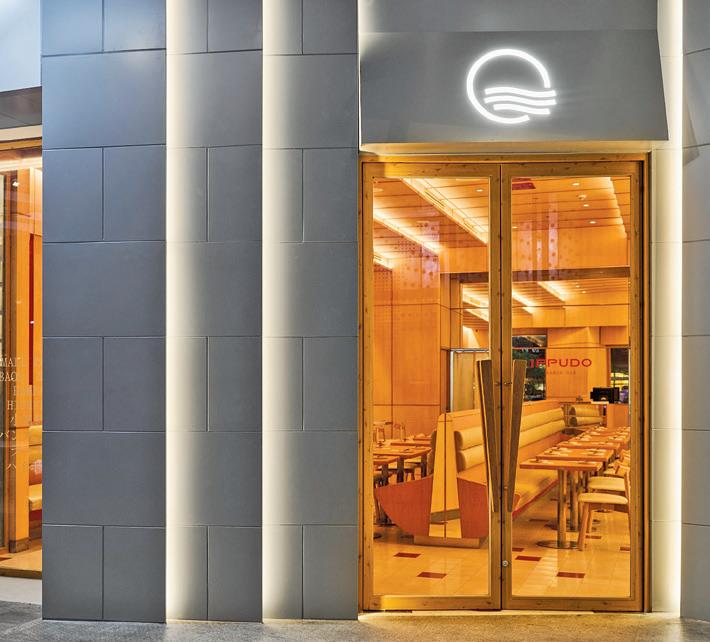

ment you walk in.
In my experience, they’re spoton with recommendations, never offering vague suggestions but always guiding you toward the best choices. Their respect and professionalism shine through, even in the simplest interactions.
The uniforms were crafted in collaboration with Commonwealth, the multi-brand boutique known for its contemporary edge, with input from founder Omar Quiambao.
Branches
Ippudo Ramen Bar opened at Uptown BGC on March 29. It’s open from 10:00 a.m. to 10:00 p.m. on Mondays to Thursdays, and 10:00 a.m. to 12:00 a.m. on Fridays to
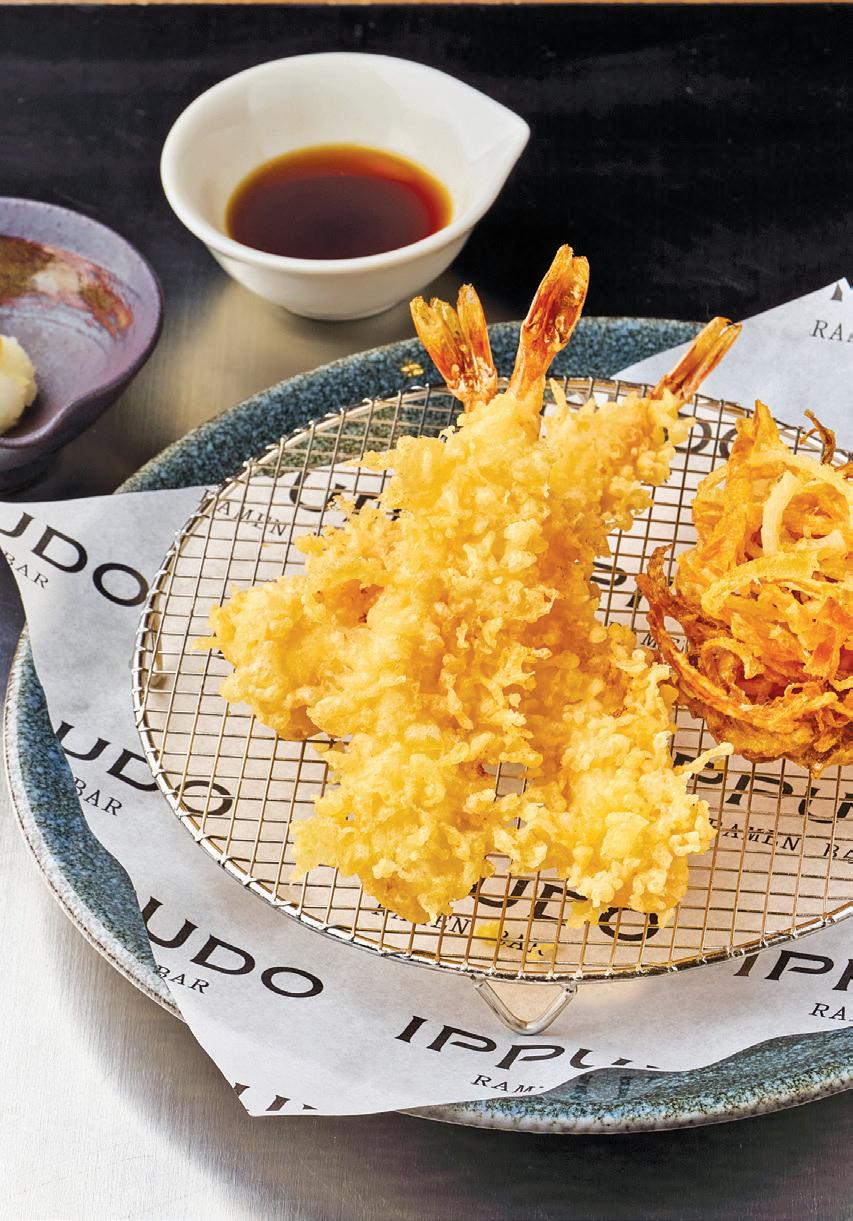

Sundays.
While there are nine Ippudo branches across the country, most are concentrated around Metro Manila, with this being the newest addition. The chain originally made its debut at SM Megamall in September 14, where it all began.
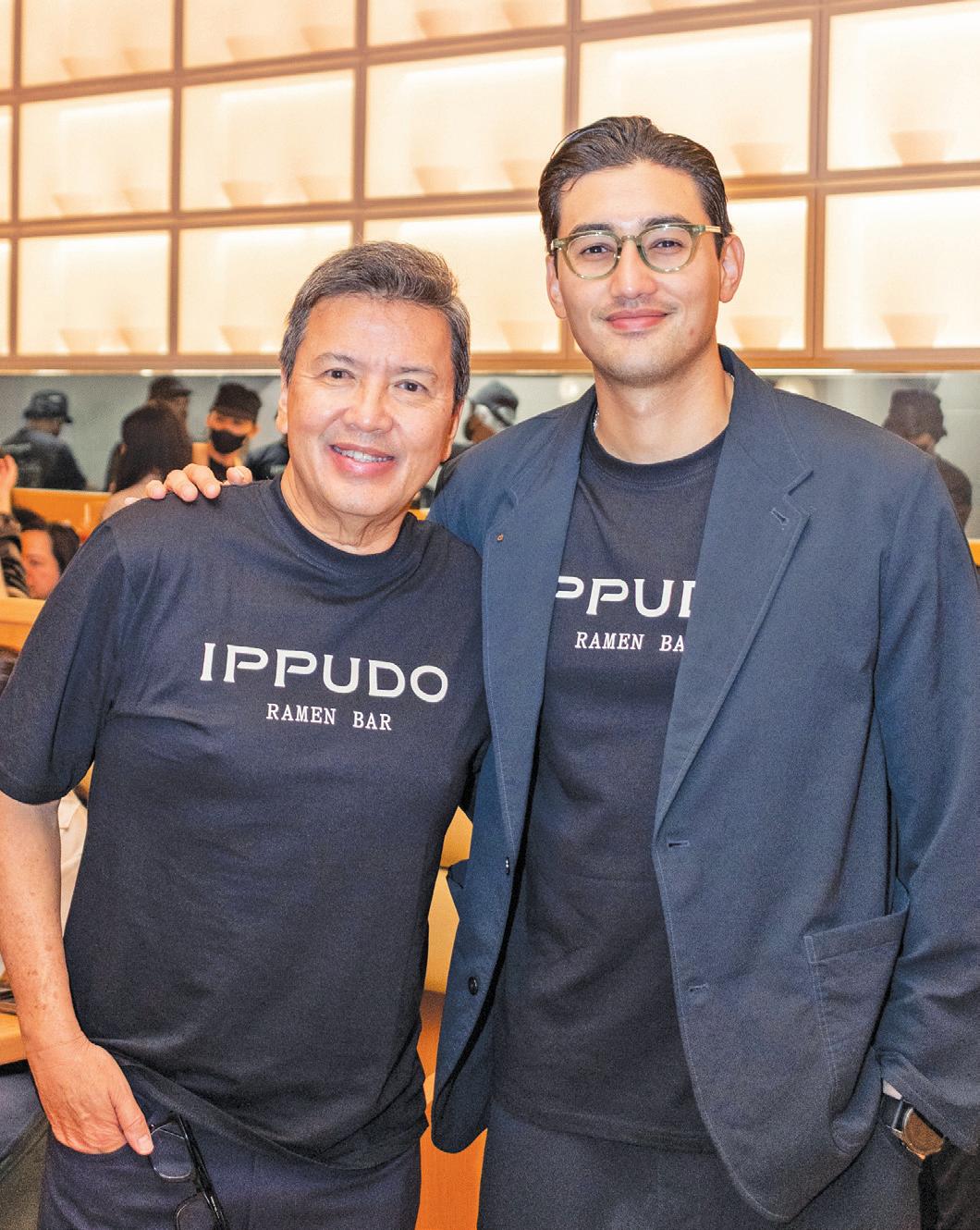
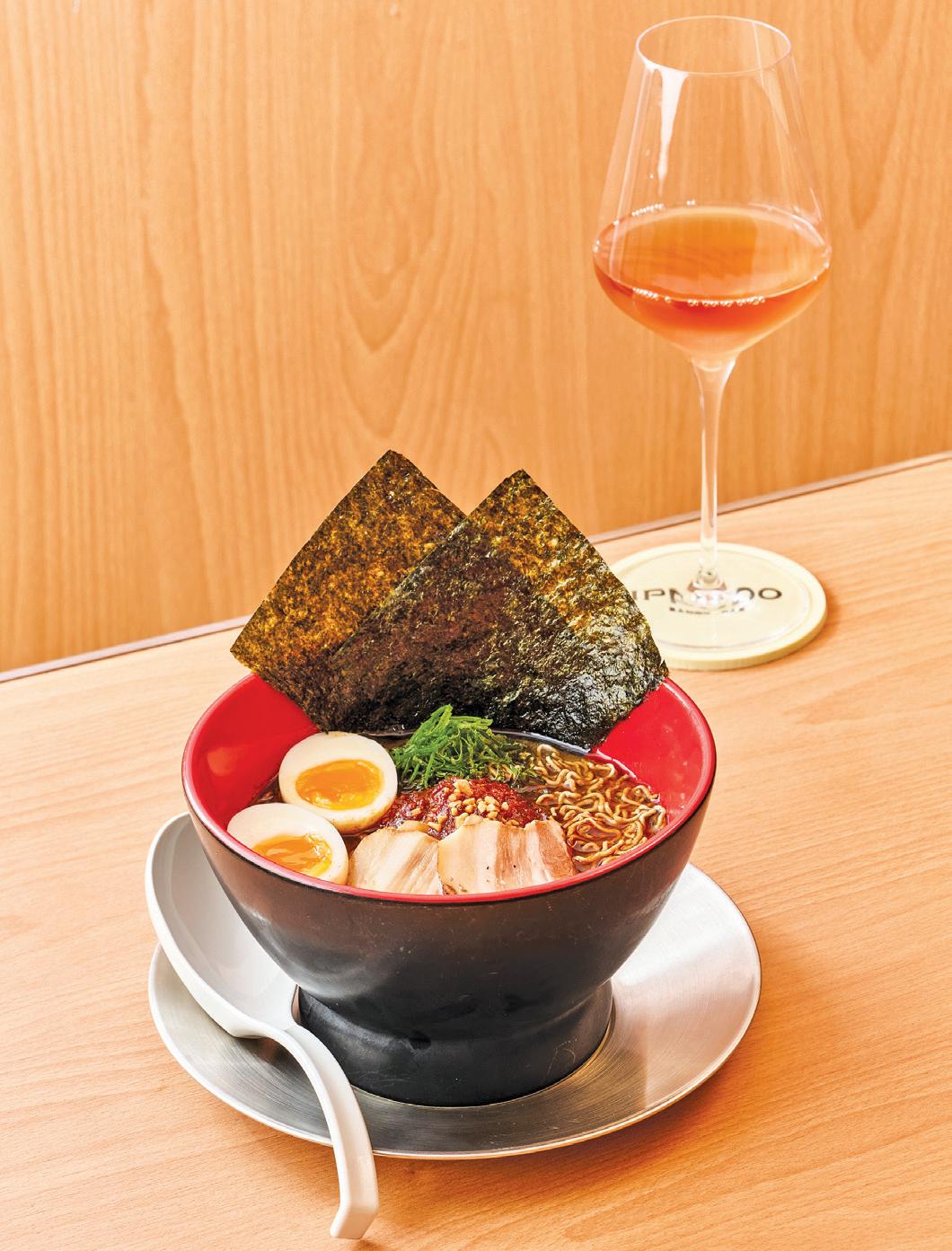

CEBU’S dynamic food scene is evolving—and SM Supermalls is proud to lead the charge. With a longstanding commitment to redefining the malling experience, SM has become the home of first-in-Cebu dining concepts, global brands, and Michelinrecognized names. From the shoreline views of SM Seaside City Cebu to the central buzz of SM City Cebu and SM JMall, a new era of culinary discovery has arrived.
“We’ve always believed that Cebuanos deserve nothing less than the best—and the first,” says

Steven T. Tan, President of SM Supermalls. “Through curated dining experiences and thoughtfully chosen food partners, we’re transforming how people dine, gather, and connect in Cebu.”
Dining firsts at SM Seaside City Cebu As one of the largest lifestyle destinations in the Visayas, SM Seaside City Cebu has been at the forefront of introducing Cebu to international food powerhouses like Hawker Chan, the world’s first Michelin-starred hawker

stall, and Tim Ho Wan, Hong Kong’s famed dim sum destination. Now, it continues to elevate the experience with Cibo, which recently opened its first-ever in-line store in Cebu—a welcome addition for fans of fine Italian fare with Filipino flair. Joining the roster is Lugang Café, now officially open and serving its famed xiao long bao and Taiwanese classics to Cebuano diners for the first time.
Elevated flavors at SM JMall SM JMall is carving a new space in Cebu for sophisticated, mod -

ern, and globally recognized culinary brands. Among the exciting firsts is Hoshino Coffee, the beloved Japanese café chain re
The heart of local flavor meets global trends at SM City Cebu Over at SM City Cebu, ABACA Baking Company takes the lead as the first-ever café concept within an SM mall. With its handcrafted pastries and strong Cebuano roots, ABACA is a proud local gem serving globalquality coffee and comfort food.
This April, Starbucks is set to unveil a first-in-the-Philippines store concept, inspired by modern native Filipino design—a seamless blend of cultural pride and contemporary aesthetic. Also arriving this April is Tavolata, the celebrated homegrown Italian restaurant making its SM debut. Looking ahead to May, foodies can anticipate the Cebu debut of powerhouse names from The Moment Group—Ooma and Manam— offering bold Japanese flavors and nostalgic Filipino dishes with a twist, respectively. Wolfgang’s Steakhouse, world-renowned for its USDA Prime dry-aged beef, and Nagi Izakaya, a creative take on Japanese pub fare, will also open their doors—another first in Cebu, all under one roof. SM Supermalls has always taken great care in ensuring that each new brand complements the Cebuano's discerning tastes, values, and lifestyles. Whether it’s the convenience of solo-dining concepts, the community atmosphere of family-style restos, or the visual richness of native-inspired design, these food experiences are designed for the Cebuano lifestyle.
To know more about SM Supermalls’

THE 4-star, 11-storey, 684-room Savoy Hotel Manila, the Philippines’ Leading Airport Hotel for four consecutive years (2021 to 2024), together with the whole Megaworld Hotels and Resorts (MHR), has committed to partner, with certain organizations, to help sampaguita planters to uplift their family lives by planting, selling seedlings and even teaching them to make Sampaguita Polvoron. With every effort spent, children gain educational support which gives more meaning in their livelihood. Their Sustainable Project

Initiatives, incorporating the national flower of the country, not only follows the company’s ethos of responsible and community-driven hospitality, but also hopes to ingrain cultural awareness of the plant symbolism and to further forward sustainable tourism.
A perennial blooming shrub, the sampaguita (Jasminum sambac) is more than just a flower, it is a symbol of Filipino values, of resilience, simplicity and humility. It may not be that attractive, as compared to bigger and vibrantly-colored ones, but its fragrance is captivating once it permeates the air. Being in the same family with jasmine, it is also used as a tea for calming effects with

mellow floral notes and a slightly bitter aftertaste. However, some chefs from MHR thought of it otherwise and have reimagined a menu that would capture a wider market, but with deeper intention.
During my trip to Boracay last year, with the Sampaguita Room Package that we had at Savoy Hotel Boracay, we were welcomed with a beautiful plate of Sampaguita Cheesecake with the aforementioned crushed Sampaguita polvoron. I was overawed and hoped to have more of the kind, not knowing that Savoy Hotel Manila’s Savoy Cafe had this Signature Sampaguita Menu all along.
Chef Kit Carpio, Executive Chef of Savoy
misconception is that it’s impossible to make at home. But actually, you can find ways to make it accessible in your own kitchen.”
That sentiment rings true as I met the author of ‘Mayumu: Filipino American Desserts Remixed’ at Guevarra’s by Chef Laudico, a heritage restaurant in San Juan, during the second installment of Taste of the Philippines: A Global Culinary Journey, a series celebrating Filipino talent and heritage.
or puto bumbong from scratch can feel overwhelming. Enter Chef Abi Balingit, a James Beard award-winning Filipino-American pastry chef, who’s all about making these traditional treats feel a little less intimidating and a lot more fun.
“I would like to debunk that it’s difficult to make all the time,” Chef Abi told Wine and Dine. “I think a lot of people say, ‘Oh, I’m not a baker and I don’t know how to, you know, I don’t feel comfortable in the kitchen.’ But if you know how to cook and if you learn, even with a recipe, it’s so... you just learn each step.” For Chef Abi, dessert-making isn’t about mastering complex techniques overnight. Instead, it’s about embracing the learning process.
“It makes it easier to improvise with flavors later on,” she added. ‘So I think the biggest
Collaborating with renowned Chef Jac Laudico, Chef Abi brought her playful and inventive takes on classic sweets to the table, proving just how approachable local desserts can be.
Classic meets contemporary
During the event at Guevarra’s, the lineup was nothing short of imaginative.
There’s this Halo-Halo Baked Alaska that blended nostalgia with show-stopping flair, then Adobo Chocolate Chip Cookies that delivered a surprising savory twist. Really, the desserts on display were a testament to Chef Jac and Chef Abi’s creativity.
Guests also indulged in Thai Tea Kutsinta, a playful nod to Southeast Asian flavors infused into a familiar rice cake classic.
“This collaboration highlights Abi’s
unique approach to Filipino-American desserts alongside Guevarra’s traditional Filipino menu,” Chef Jac shared. “The dishes showcased, which are featured in Abi’s James Beard-awarded book, reflect a fresh and exciting take on Filipino flavors. We’re thrilled to have these desserts as part of our offering.”
Throughout the month of March, diners at Guevarra’s enjoyed these inventive desserts as part of the restaurant’s buffet selection.
Sweet story
With influences from centuries of trade and colonization, every bite tells a story of resilience, adaptation, and creativity.
“Our unique history, shaped by over 300 years of Spanish influence, has given rise to a cuisine unlike any other in the region. Our breads, pastries, and desserts are a delightful fusion of European tradition adapted to Filipino tastes,” said Chef Jac.
“With Latin-influenced sweets and Southeast Asian-inspired delicacies rich with coconut, rice, corn, and local fruits, Filipino desserts are ready to be embraced by the international market.”
For Chef Abi, that history is a source of inspiration and a playground for creativity. If re-

Manila, has been fascinated with sam-
growing up, being abundant in his mother’s garden, hence, when their corporate marketing asked them about formulating dishes that incorporate the said flower, it was not new to him anymore. Having known about jasmine tea and its culinary applications, typically as a tea in Chinese tradition, he hinted that sampaguita can also work like other edible flowers. It was just last year when they came up with Smoked Salmon Sampaguita which made use of fresh flowers. Along with the dilemma of having too many fresh flowers came opportunities to find other uses for it, like drying
them up and using them to smoke fish and meat. Chef Kit began experimenting with sampaguita, incorporating it into the dishes by mixing it to salt rubs to cure meats. They also used more of the dried flowers in both their savories and desserts.
In the Pan Seared Sea Bass with Rice Pilaf, the fillet was seasoned with spices, along with the crushed dried flowers, before pan-roasting which complemented well with the tart Ripe Mango Salsa served with it. Meat-lovers will get a kick out of the Barbecue Rub Pork Belly where pork liempo was generously seasoned with their homemade dry rub consisting of orange and lemon zest,

sources were limitless, she would love to make braso de mercedes, a classic Filipino meringue roll, for all her loved ones.
“I think for me, I feel like my parents have historically had a hard time with braso de mercedes,” she shared. “And I think that because eggs are so expensive right now in the US… there’s such a big shortage that it would be very wonderful to be able to make braso de mercedes for all my family and friends.”
When it comes to desserts in need of a glow-up, she believes in sapin-sapin’s untapped potential. “I think there’s like such a beautiful, like the ube, the color, like the gradient of three different colors is so gorgeous that I think

a lovely glaze where sweet and savory meld into one bite. The sampaguita flavor is not really evident as it only gives a faint flavor in the aforementioned dishes but, somehow, adds a complex flavor and aroma to the meat. For an appetizer, maybe a

there’s a lot of ways to play with the flavors of each of the layers. And I think that needs a little bit more attention.”
Of course, not every dessert experiment turns out as planned. She recalled her attempts to modernize her mom’s beloved maja blanca. “In my book, I put malted milk powder and then top it with candied Fritos. And so it’s a totally different, a little bit of a flavor profile, but still very cornforward,” she said.
“I just think it’s really fun that, you know, it’s a challenge, but it’s still somewhat possible to translate the flavors in different ways,” she added.
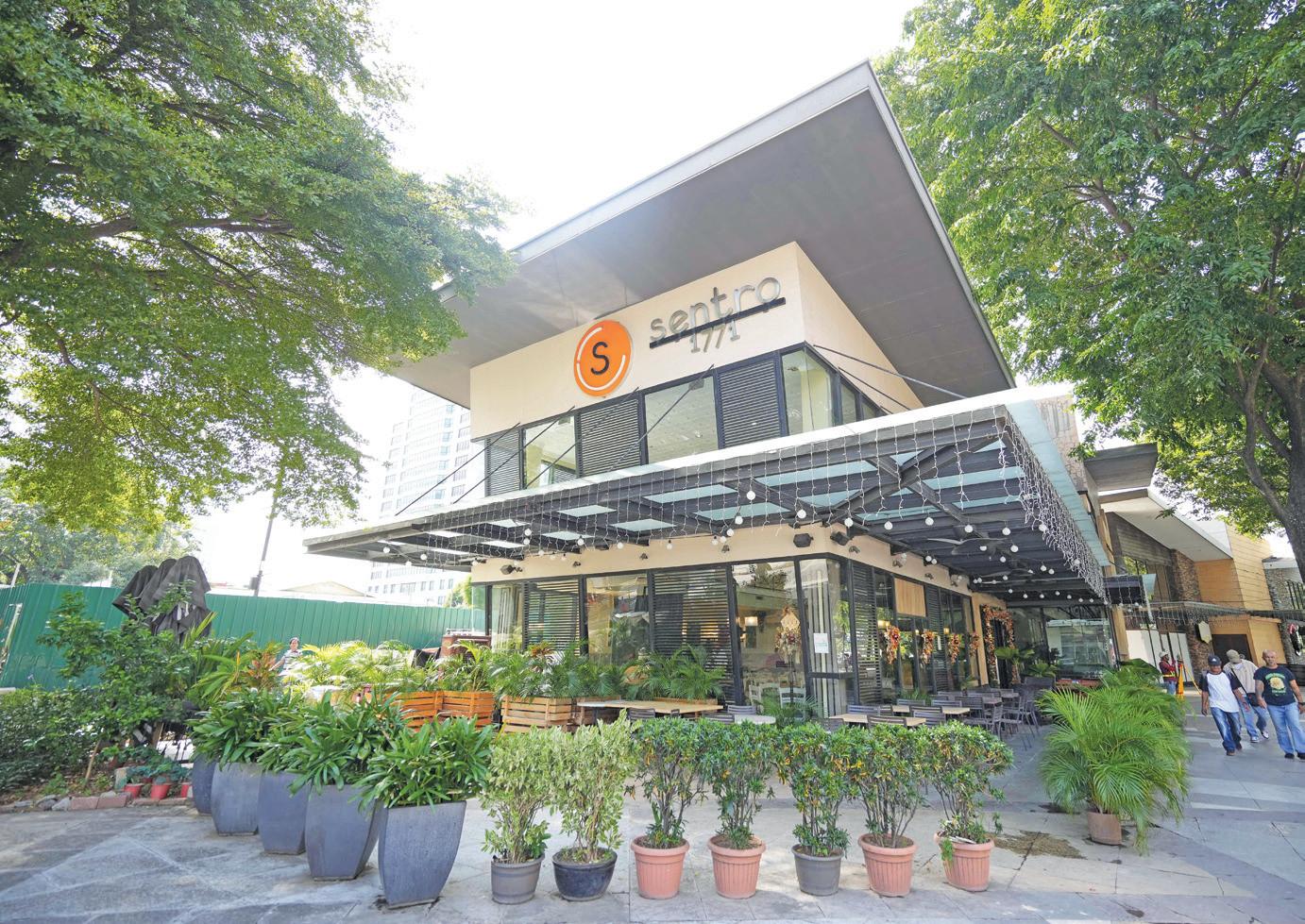




FBy Rory Visco
OR Chef Vicky-Rose
Pacheco, Chief Operating Officer and Executive Chef of Sentro 1771 and who is recognized as a pioneer in the concept of fusion cooking, she believes it was serendipity that led to the birth of the concept. She narrated that in 1997, Cabbage and Corned Beef was part of the menu at Chateau 1771, where Sentro is also part of the 1771 Group of Restaurants, but it was too Western. “One time, a big pot of beef broth was left over but it was too salty so she put something to make it sour and turn it into “sinigang.” “There was really no conscious effort to make it a Filipino dish. Call it serendipity or probably because of the desire not to waste anything,” explains Pacheco in a recent chat with Business Mirror at Sentro 1771’s Capitol Commons branch along Meralco Avenue corner Shaw Blvd., Kapitolyo in Pasig City. Perhaps it was the reason why Sentro 1771 was born in 2002 in order to serve modern Filipino food they like to eat, whatever suits their palate regardless of the type of cuisine, and became a modern Filipino restaurant. “In my heart, I gave what Filipinos wanted in terms of food they wanted to eat. I just
streamlined everything without departing from being a non-traditional restaurant.”
She admitted it was easier before but has become more difficult because of the competition where practically any restaurant at any corner offers fusion dishes. Before, people didn’t want fusion because it’s confusing. “But you can’t really avoid fusion because it’s in our way of life–it’s in the arts, music, language, of course food–-it’s everywhere. However, fusion is bad if the food doesn’t taste good. Those who do fusion cuisine should have a perfect understanding and respect of the cuisines they want to fuse; otherwise, it will be a disaster.”
Pacheco pointed to the Corned Beef Sinigang as an example. She explained that the reason why it worked was because the two dishes–Sinigang being Filipino and Corned Beef being American but familiar to many Filipinos since they eat it for breakfast –are already part of Filipinos’ lifestyle. “Somehow, their flavors are not too far apart from each other; it just so happened that they were combined in a single dish, and it turned out they were a match. Perhaps, I was just lucky,” she continued with a slight chuckle.
Perfect fusion SHE also credits the introduction
of fusion cooking in the country to the fact that many Filipinos are now able to travel to various countries and were exposed to different cuisines. Once they’re back home, they will try to replicate the dish they tasted in another country, and attempt to make their own version, using Filipino ingredients. On the flipside, she said that also works for Filipino cuisine being introduced in a different country, especially for overseas Filipino workers, who cook Pinoy dishes they love in the country where they work to overcome their homesickness not just for their families but also of the food they eat.
In order to establish a good fusion of dishes, it takes substantial wisdom, experience, and expertise to be able to do the correct fusion of two dishes, which can reach a maximum of three dishes, she said. “It would be really difficult since in some cuisines, the lines are really blurry so there may be some confusion, not unless the chef is really, really good,” Pacheco affirmed.
Some of the Sentro 1771 dishes that captured the imagination of diners who are open to try dishes that are familiar to them, but with a twist, include showstoppers like Bangus in Calamansi Butter, the Sentro Clubhouse sandwich, which many claim as the best, the Pinoy Beef
the
had impeccable tastes, something anyone can be familiar with but with a different attack on the palate.
Fearless forecast for Pinoy food WHEN asked by BusinessMirror as to the next dish that will hit the international consciousness, she said it’s “sisig,” without batting an eyelash. “I think sisig is in the running. Even if the dish uses unfamiliar or rarely used animal parts, in France, for example, they have already adopted the ‘nose-to-tail’ philosophy, even in England. That’s why I see ‘sisig’ as one dish that can make Filipino cuisine more popular abroad.”
She noted that when foreign tourists arrive in the country, they usually look for ‘sisig’ and they like it because the dish is really savory and offers different textures like chewy, crispy, crunchy.
One thing for sure, Pacheco avers she will not follow a trend just because it is a trend. “I will do something because it tastes good, and it is the right thing to do. I believe in keeping the integrity and authenticity of cooking. Sentro 1771 will remain to be a modern Filipino restaurant,” she concluded.
By Vincent Peter Rivera
Kcuisine shone brightly this Filipino Food Month at Belmont Hotel Manila’s “Pamana” celebration, featuring Chef Felix Niño Asuncion’s authentic and sumptuous heirloom recipes.
Translating to “heritage,” Pama-
na is a special weekend dinner buffet that showcases the legacy of taste and heritage of Philippines’ most revered culinary traditions. Mayann Malapote, Director of Operations of Belmont Hotel Manila, emphasized their commitment to promote the country’s rich history through a quality dining experience, stating, “At Café Bel-
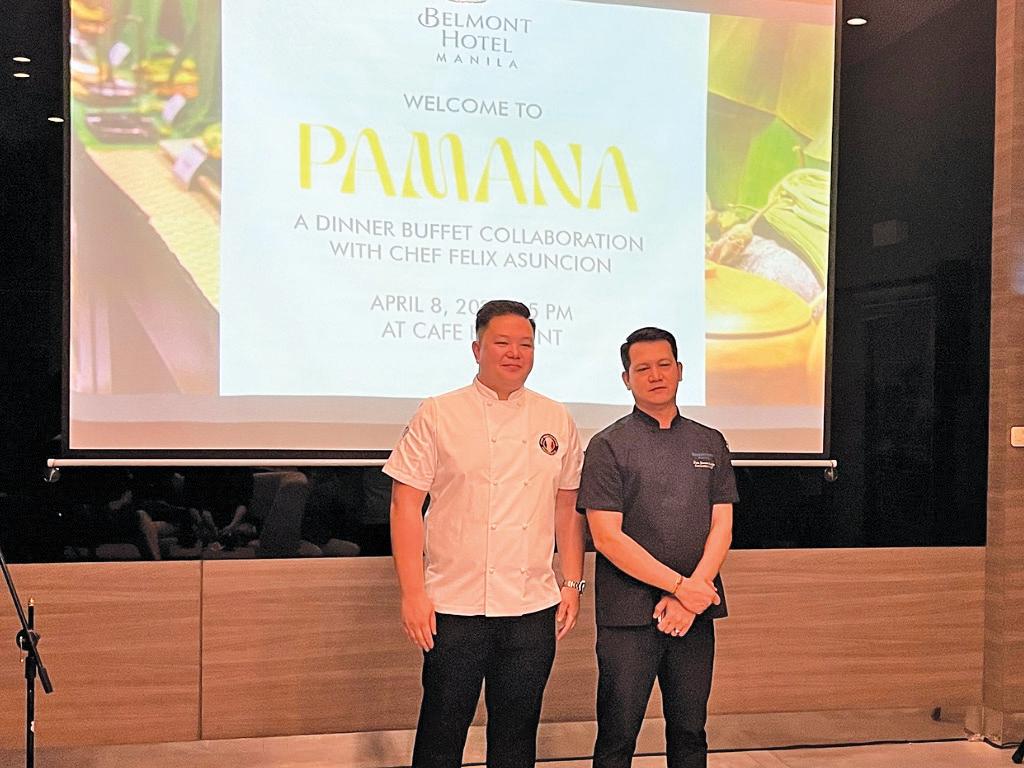
mont, we’re not just about offering great food, we are offering an experience that brings people together to appreciate our Filipino culture.”
Held every Friday and Saturday from 6:30PM to 9:30PM at Café Belmont, this month’s Pamana underscored the unique ingredients, traditional cooking techniques, and opulent flavors of Pampanga’s delicacies through Asuncion’s creations.
“I love the word Pamana because it talks about what we will leave behind. Sometimes, Pamana is more than just gold, land, and properties—it talks about stories, values, and inspirations of our families,” said Chef Asuncion, describing the enduring stories engraved behind the Kapampangan dishes which he inherited from past generations of his family.
To fully immerse diners in Kapampangan culinary heritage, Chef Asuncion curated two signature heirloom dishes for the dinner buffet: the deeply flavorful Asadong Matwa and the boldly aromatic Begukan Babi.
The Asadong Matwa, a testament to time-honored Pampanga
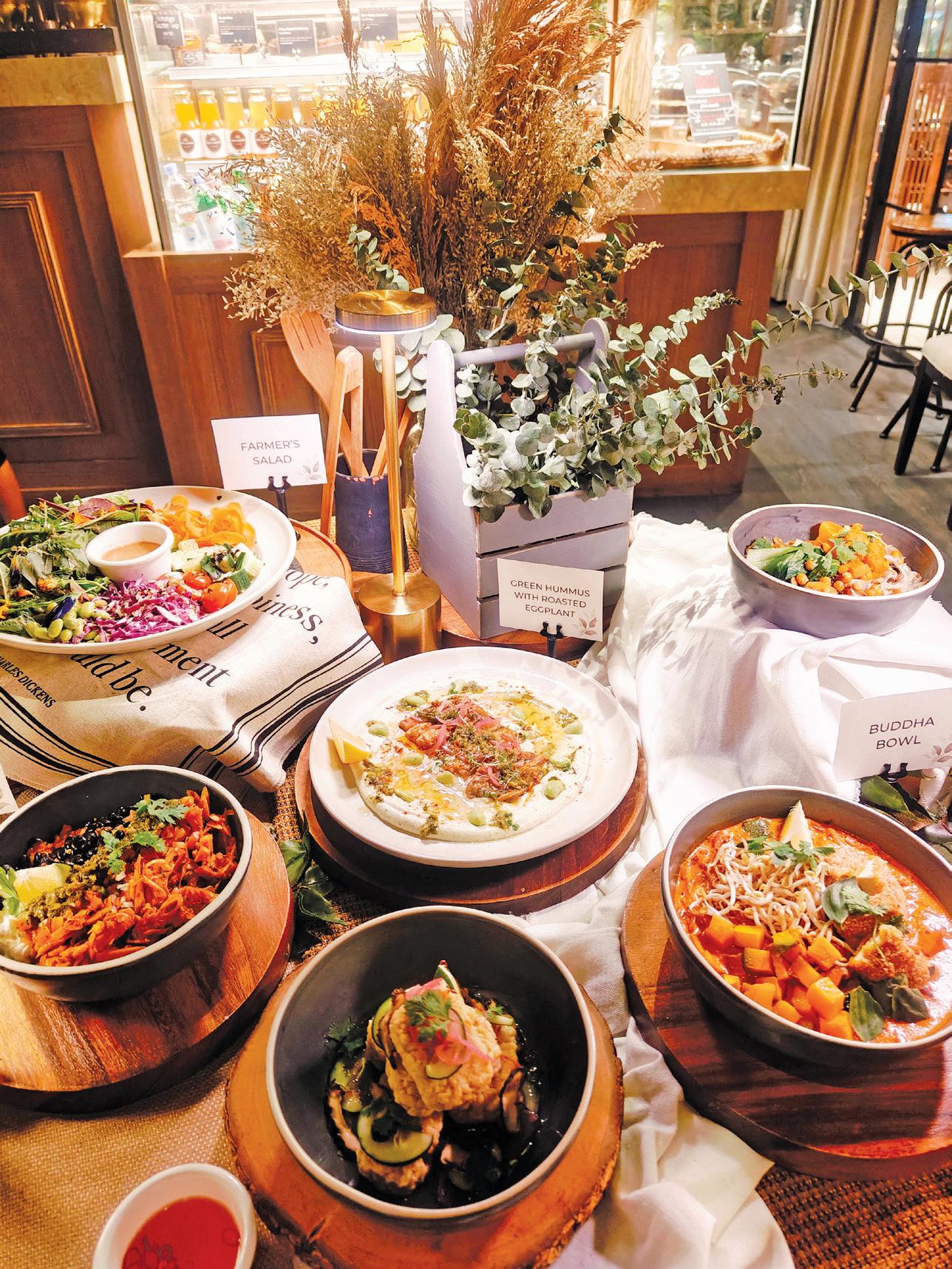
By John Eiron R. Francisco
SUMMER is the season when people naturally turn their attention to health and wellness—often looking for ways to shed a few extra pounds or simply embrace a healthier lifestyle.
At The Wholesome Table, a decadestrong, homegrown farm-to-table restaurant chain, this seasonal shift aligns perfectly with the launch of their new summer menu: a vibrant lineup of plant-based dishes rooted in sustainable sourcing and fresh, seasonal produce.
“People often get health-conscious during two times of the year: the start of the year and just before summer. It’s when they think about losing a few pounds or simply feeling better in their bodies,” Bianca Araneta-Elizalde, the restaurant’s founder and wellness advocate, told the BusinessMirror at their latest branch in Shangri-La Plaza, Mandaluyong City.
“So, it seemed only fitting to introduce a menu that supports that intention,” she added.
Included in the menu are The Wholesome Table’s unique take on popular dishes as well its own originals that include like Farmer’s Salad, Green Hummus with Roasted Eggplant, Thai Crispy Rice, Vegetarian Laksa, Buddha Bowl and Panna Cotta
The menu also features ingredients that have never been used before in their kitchen, such as sorrel, a leafy green with a refreshing tartness, and jackfruit, a versatile fruit often used as a plant-based alternative to meat.
kitchen traditions, presented a sweet and savory pork stew achieved through slow cooking. Complementing this was the Begukan Babi, a robust pork dish simmered in bagoong that vividly showcased the defining, umami-rich flavor profile of Kapampangan cuisine.
Beyond featuring the heirloom dishes, Pamana and Chef Asuncion are both committed to sustainability and local sourcing in continuing the legacy of Filipino cuisine.
“Sustainability means creating systems that allow our local farmers and food producers to thrive,” Chef Asuncion mentioned. “We need to support our local producers because they really need help.”
Presently, Chef Asuncion is an entrepreneur and the CEO of Asuncion Family Ventures, Inc. who mentors young culinary talents and advocates for eco-conscious practices. His personal flair and culinary creativity contributed in crafting dishes that truly embodied the essence of “Pamana,” illustrating the region’s evolving identity and innovative spirit through its rich culinary traditions.
Many of the ingredients are grown on the brand’s 30-hectare farm in Lipa, Batangas, with five hectares currently in use. Guided by permaculture principles and biodynamic farming, the farm gives The Wholesome Table greater control over its sourcing.
“We were very careful about sourcing,” Araneta-Elizalde explained. “But the reality is, in the Philippines, there’s no real certifying body for organic or sustainable farms. Abroad, you’ll find certifications everywhere, but even those can be questionable. So we asked ourselves—how do we truly know where our food comes from?”
That question led her to start her own farm.
“At least this way, I can be there. I can see how things have grown. It gives me peace of mind,” she said. “We follow systems that use fermented inputs, composting, and other biodynamic methods. It’s an entire ecosystem, and it’s something I’ve grown passionate about—maybe even more than eating itself!”
While the early years of the restaurant required her to visit farms personally to inspect growing methods, having Wholesome Farms has now given them greater control and traceability.

“I want to leave something for my kids, something that will teach them sustainability and self-sufficiency. But also want to make it accessible to everyone,” she said.
‘Inclusive menus matter’ While today’s diners are more attuned to wellness and conscious eating, she recalled that it wasn’t always the case. In the early years, educating customers was key.
“We used to print our manifesto on placemats. And I’d see guests reading them and having this lightbulb moment—like, ‘Why wasn’t this the norm before?’“ she shared. She pointed out how so much of the food people consume is heavily processed, filled with additives and chemicals that are masked by flavor enhancements.
“A lot of people don’t realize how not-fresh their food really is, or how many additives go into it just to make it taste good or addictive,” she said. “These are the things we don’t allow in our kitchen—not at home and
“I’m hoping that by the end of the year, we’ll be producing more than what our restaurants need,” she said. “When that happens, we’ll be able to offer the same wholesome produce directly to the people.” She shared that the brand’s farm is not just a supply chain for The Wholesome Table—it’s part of Araneta-Elizalde’s broader vision for a healthier, more sustainable future. In time, she hopes the farm will open its doors to the public, allowing visitors to see where their food comes from and learn how to grow their own.

ONE look at the recently opened Caffè Allor Ristorante and you’ll feel like you’re transported to an piazza in Italy with its al fresco-like interiors punctuated by a central fountain— except for the fact that you’ll be partaking of a fusion cuisine that blends the best of both Italian and Filipino flavors.
While the restaurant offers an impressive and extensive selection of pasta dishes and Neapolitan pizzas, renowned for their thin, crispy crust and premium ingredients, originating from Naples, Italy, I thought what really sets Caffè Allor Ristorante apart is its unique take on popular Filipino dishes.
Mark further revealed how he was smitten by the picturesque and timeless streets and architecture of Siena, Tuscany where his honeymoon took place. He told his wife that he’d love to have a restaurant inspired by this captivating backdrop.
An entrepreneur whose business ventures include supplying premium ingredients to food-service businesses, Mark is no stranger when it comes to taste and flavors.
It’s no surprise that he also became motivated to create his own interpretation of the dishes he and his wife enjoyed during their trip.
Mark also noted that ingredients used for Caffè Allor Ristorante’s Italian dishes, in particular are


Standouts include Mango Sinigang, a version of the traditional sour soup enhanced with crispy pork and ripe mango; the Golden Egg Waffle, Caffè Allor Ristorante’s take of “kwek-kwek” adorned with edible gold; and the Sisig Fiore, pork sisig garnished with quail eggs and presented in an edible bowl. I’ve had the chance to try these dishes and all I can say is, anyone who comes here should, too.
Caffè Allor Ristorante’s fusion concept is further underscored by coffee variants made from locallysourced beans but prepared Italian style and distinguished by their strength, frothiness, and richness.
Also included among the restaurant’s selection of dessert and savory crepes is the must-try Puto Bumbong Crepe.
Located along the relatively laidback part of Quezon City in Sct. Reyes Street, Caffè Allor Ristorante has a fascinating history behind its name.
“The name is a combination of my parents’ names. My father’s name is Albino, and my mother’s name is Lorita, so Al and Lor. At the same time, I wanted to do something to honor my parents. In my other business, my parents inspired me to ensure that it develops, and I would like to honor them as I grow this restaurant.,” shared owner Mark Wang.
By Lourdes Molina-Fernandez
IT all began as a pantry practice during the pandemic. The first batch of employees allowed to go to the office started bringing their own favorite condiments to the pantry, as some sort of “comfort food” companion during those difficult times. Slowly but surely, the younger ones in the group noticed the bottles –mostly containing all types of vinegar--had begun occupying more space on the narrow shelf.
And then, when lockdowns lifted and more types of homecooked food made their way to the office’s periodic potluck lunches, the vinegars became ideal companions for all sorts of fried food (fried lumpiang togue, okoy, etc.) and snacks like chicharon and fish crackers.
Dipping these in vinegar made for a hearty meal and soon, the “vinegar club” started researching the health benefits of vinegar and acting like connoisseurs each time someone brought in a new kind.
Since early civilization, vinegar had been chronicled as being used for, among others, medicinal purposes; as an antibacterial agent; treatment for, ironically, acidity.
These days, in our office pantry, the bottles of vinegar hold court, and discussing the origins and ingredients of each one is a favorite conversation fare over lunch.
They help workers “extend” their humble viands so that they can share even small portions of fried stuff – usually dried fish like danggit or ispada fried to a crispy brown – and drowned in vinegar.
Recently, we did an informal poll among the staff and asked what was their favorite vinegar, and came up with interesting results.
The most popular, it seemed, was the coconut vinegar, with the Zumigui brand (coconut sourced from Apayao), the Pinakurat and the Sukang Paombong (fermented in Bulacan, originally in bamboo or the “bumbong”) cited by our “pantry gang” as the best. According to some researchers, coconut vinegar is a source of antioxidants, and taking it daily helps control cholesterol and sugar levels. Some people swear it helps in weight loss.
Sukang paombong denotes the vinegar’s origin – the town in Bulacan derived from the word “bumbong” or canister made of bamboo, used in the old way of fermenting the vinegar.
Zumigui coconut vinegar, on the other hand, comes from Apayao province’s fairly recently discovered “treasure”—high quality coconuts that had not been deemed earlier as a cash crop in that north Luzon province. The patriotic, enterprising couple who had a processing plant fabricated in their place had originally set it up with the intent of making and exporting virgin coconut oil. A pleasant surprise: their secondary product, coco vinegar, now exceeds their sales from coco oil,
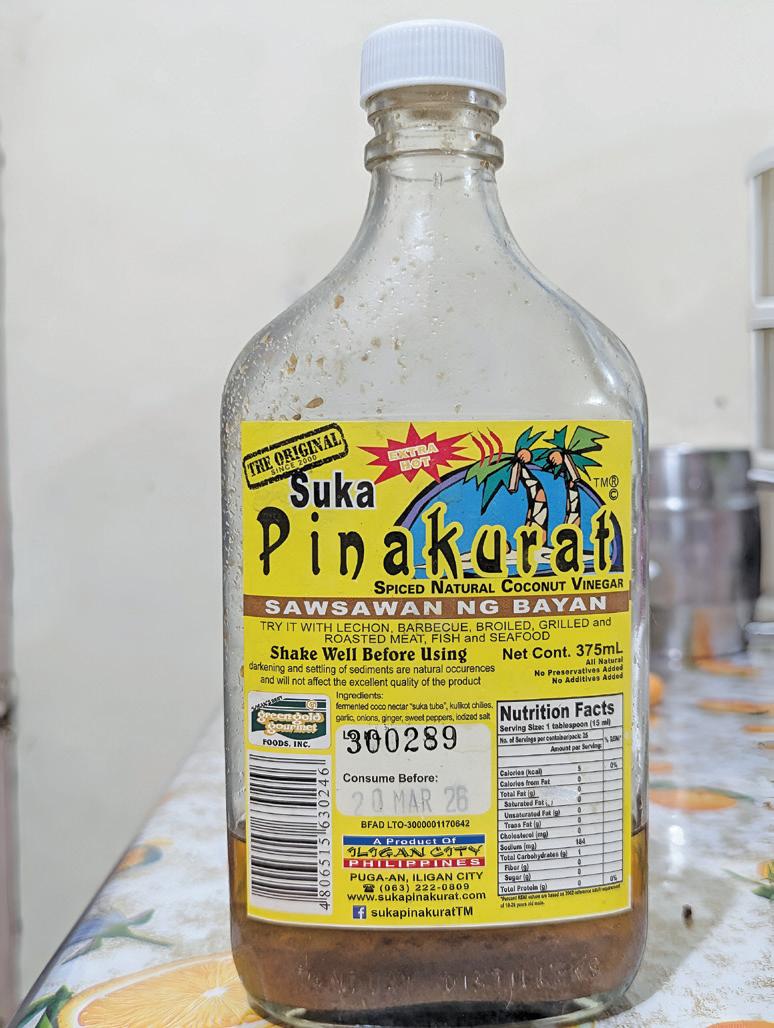
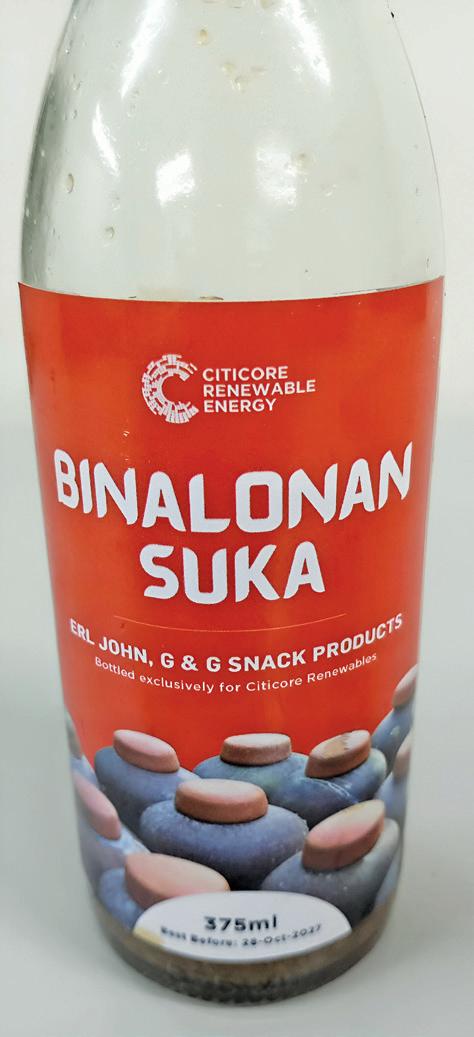
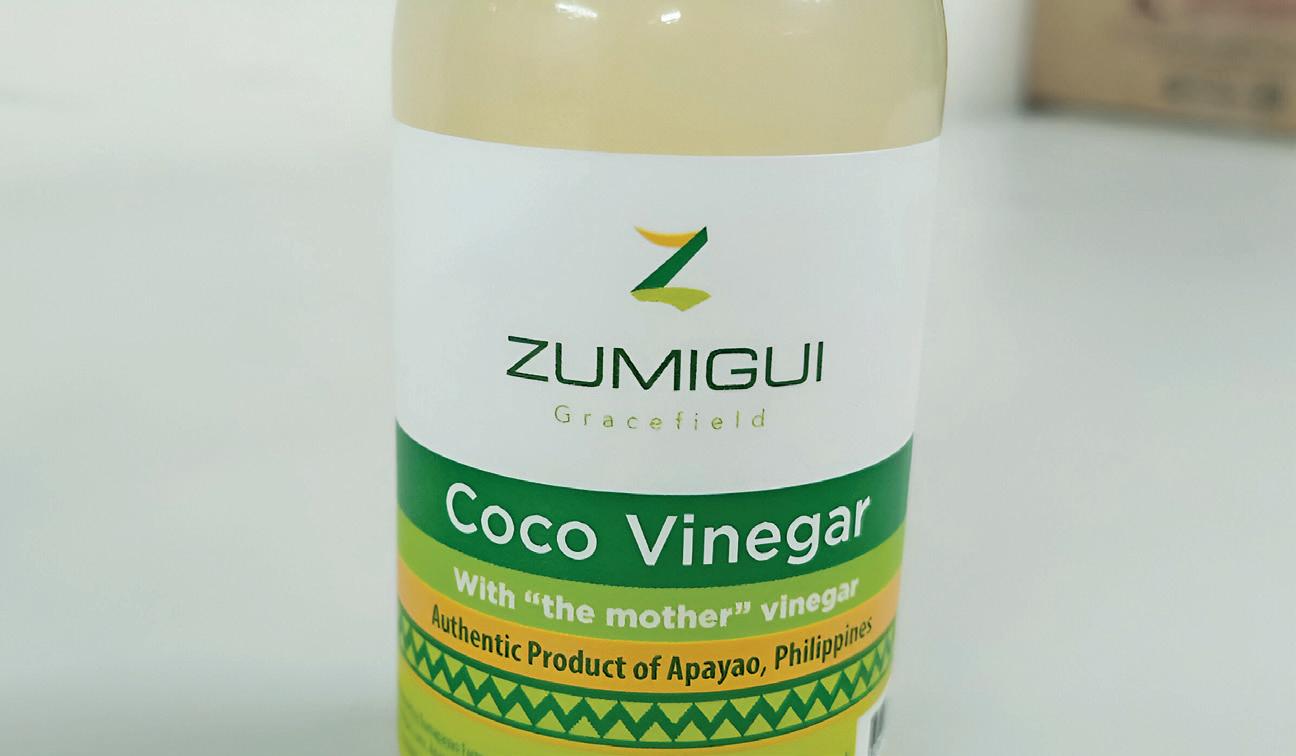
their original product. And most of the vinegar is being exported.
Another favorite vinegar derived from coconuts is Pinakurat, made from fermented coconut sap (sukang tuba) and infused with spices like chili, garlic and ginger.
Another favorite is Sinamak, derived from white cane and spiced with garlic, salt and peppercorns and ginger, among others.
Then there are the more commercial ones found in groceries, e.g., Datu Puti and Marca Piña Sukang Puti Cane Vinegar, which is made from natural, fermented sugar cane juice .
Also prized, though somewhat pricier, is the coconut vinegar sold
under the brand name of “Margins,” the line of products turned up by urban poor households being assisted by Caritas Manila. The indispensability of vinegars from our pantry gang was recently demonstrated once again when, after someone opened a big plastic bag of fish crackers and announced that she was going to “drown it in suka” to serve as a viand because payday was still in the distant horizon, the rest of the gang brought out an assortment of small dipping bowls and filled these with vinegar while partaking of the fish cracker as ulam. As we Pinoys like to put it, “sa suka lang talo talo na!”
LOOKING for a place where your cravings don’t have to compromise?
of the highest quality, featuring imported Italian products such as their tomato sauce, olive oil, truffle, flour, and cheese.
But while Caffè Allor Ristorante is ideal for both solo diners and couples looking to enjoy a good meal amidst a very romantic ambiance, Mark is also quick to point out that the restaurant is ideal for the whole family.
“The goal for the restaurant is to create a family-friendly space where families can relax, enjoy a proper meal, and share delicious food together,” shares Mark.
With a private function area accommodating that can accommodate around 15 to 18 guests, equipped with a projector and basic sound system, Caffè Allor Ristorante is also perfect for intimate product launches or special celebrations without any hassle.
Caffè Allor Ristorante is located at 83 Scout Reyes corner Scout Delgado, Brgy. Paligsahan, Quezon City. Operating hours are from 9:00 AM to 11:00 PM daily. Motorists will be happy to know that the restaurant offers designated parking slots. For reservations, special events, and inquiries, guests can call 09171378463 or email information@ allorprimegroup.com. Follow Caffè Allor Ristorante on Facebook, Instagram, and TikTok @caffeallor for updates and promotions.
Whether it’s for catching up with friends, solo soul-feeding, or group hangouts with picky eaters, My South Hall is shaping up to be the metro’s next favorite food hub.
Tucked into the ground floor of SMaison Conrad Manila, this multi-brand dining destination reimagines the traditional food court with a touch of sophistication—think tambayan, but elevated.
Its sunlit interiors, curated lineup of global flavors, and communal vibe are perfect for discovering new favorites together.
Here’s a taste of what’s cooking: Fish & Co.
Fish & Co. reels you in with its famous Best Fish & Chips in Town, being crispy, golden, and flaky in all the right ways.
But the real catch? Their generous combo meals start at just P385. You can build your own set with an appetizer, including their Caesar Salad or Nori Cheese Nachos, as well as a hearty main, from seafood aglio olio to chicken rice bowls, and a drink. Really, it’s a value-packed option that doesn’t skimp on flavor.



Sunday, April 27, 2025
Edited by Jose F. Lacaba

IT was National Artist Ricky Lee who expressed it best: “Buong buhay ni Guy, nagbigay siya nang nagbigay, hanggang sa halos wala nang natira sa kanya.
used to her giving, we frequently forgot that she also had needs. So, in the midst of our grief today, we would like to say to her, ‘Guy, on behalf of the millions of people you touched, embraced, wiped their tears, and changed their lives, accept our never-ending thanks. We give thanks for having lived in a time that you were here. A Nora Aunor happens only once’].”
NORA ON SOCIAL MEDIA
wives, husbands, daughters, sons, students, migrant workers, scientists, academicians, workers, and so many others.
Some posted photos of the Superstar. Many narrated instances, moments, or events when Nora Aunor touched their lives. Here are some of the posts:
SOCIAL media held a virtual festival of Nora Aunor posts the week that the one and only Superstar of Philippine cinema, TV, and radio died on Holy Wednesday, April 16.
[Her whole life, Guy gave and gave until there was almost nothing to give. And because we had become
Attayo,dahilnasanaynatayong siya ang bigay ng bigay, madalas ay nakakalimutan natin na siya man ay may mga pangangailangan din. Kayasagitnangatingpagdadalamhati ngayon, gusto natin sabihin sa kanya, ‘Guy, sa ngalan ng milyunmilyong mga taong pinukaw mo, niyakap mo, pinahid mo ang luha, binago mo ang buhay, tanggapin mo’ngamingwalanghanggangpasasalamat. Nagpapasalamat kami na nabuhay kami sa isang panahong nariritoka.Minsanlangmangyayari ang isang Nora Aunor.’
Joining the posts from media outfits, media practitioners, and movie celebrities were posts of non-celebrities—mothers, fathers,
“You are finally HOME to our CREATOR Ms. Nora Aunor. My family is a silent fan of yours. I remember when were young, my sister and I got fever and we got well when my uncle gave us a picture of yours, with dedication. He met you in one of the private occasions with high officials of government. Maraming salamat po…”—Joy Acena
“Way back in the 70s, when I was in second year until 4th year high school, I always escaped from my
class 1 pm to 5 pm, just to watch Nora’s movie, the very first I remembered, Nasaan ka Inay and Together Again where Pip is the leading man. That was very sentimental. I cried from the start to end…ang ganda ng story. Since then, pag may coming movie si Superstar Nora Aunor, pinag-iipunan ko yan. I always keep on watching the movies of Ate Guy, my superstar, nag-iisangsuperstar Nora Aunor…”—Tita Barcos Ybarita
“Today, we bid farewell to the one and only Superstar, Ms. Nora Cabaltera Villamayor or popularly known as Nora Aunor—a pillar of Philippine cinema, a beloved voice in music, and an icon of Filipino artistry. In 2002, she was honored through the Hibiscus Celebrity Star Series of the UPLB Institute of Plant
Breeding. The variety Hibiscus rosasinensis ‘Superstar,’ developed by Mr. Reynaldo B. Pimentel, bears her name—its striking red petals with yellow-orange splashes and a dark red eye reflecting her fiery spirit and enduring brilliance. As the nation observes a Day of National Mourning, we remember not just an artist, but a cultural treasure whose legacy will forever bloom in the hearts of the Filipino people. Maramingsalamat, Ate Guy. Paalam sa aming Superstar.”—Pam Custodio
STARS & POLITICANS
CELEBRITIES and adoring fans attended the wake of Nora
Continued from page 3
Among the first to pay their respects on the first night of the wake were Vilma Santos, Robin Padilla, Gina Alajar, Imelda Papin, Ricky Lee, Boots Anson-Roa, Nadia Montenegro, Melissa Mendez, and Jericho Rosales.
Nora’s ex-husband Christopher de Leon attended the second day of the wake. Also present were Charo Santos, Malou Santos, Director Joel Lamangan, Richard Merck, and John Rendez, Star-studded characterized the last night of the wake. These included: Cocoy Laurel, Deborah Sun, Rosanna Roces, Ai-Ai delas Alas, Darius Razon, Daisy Romualdes, Maribeth Bichara, Portia Ilagan, President Ferdinand “Bongbong” Marcos Jr., First Lady Liza Marcos, Senator Imee Marcos, former Philippine President Joseph “Erap” Estrada, Tirso Cruz III, Rochelle Pangilinan, Judy Ann Santos, Ryan Agoncillo, Boy Abunda, Sheryl Cruz, Ricky Lee, Boots Anson-Roa
SCENES FROM THE MET
WEARING glasses, a black t-shirt, and pants, Ma. Liza Balde Tesoro, 59, braved the heat of the morning sun and fell in line at the entrance of the Metropolitan Theater to attend the honors given by the National Commission for Culture and the Arts (NCCA) and the Cultural Center of the Philippines (CCP) for the late National Artist Nora Aunor on April 22.
“Through generations, starting with my mother, we have been fans of Nora Aunor. My mother was very proud of Nora and she told us many stories about her,” Tesoro said, adding that her favorite film of Nora was Himala.
Also making a beeline for the superstar’s necrological services were scores of Noranians, some in white t-shirts and holding photos and other memorabilia of the superstar.
Fans from Bulacan rented buses to reach the Met. Still, more fans had to wait on the left side and at the back of the Metropolitan Theater. These fans said they were not able to register and had to content themselves looking at photos of Nora Aunor at the Met.
The St. Peter Chapel’s hearse arrived with Nora’s record of the song, “All Alone Am I,” wafting in the air. With full military honors, Nora’s
casket was carried by Navy-uniformed pallbearers and received by NCCA officials and Manila Mayor Honey Lacuna.
Solemnity, reverence, and awe filled the Met as government officials, National Artists, those closest to Nora in the entertainment sphere, and always—the fans, celebrated the life and greatness of a Nora Aunor.
Among those who held tributes were Ma. Carissa Coscolluela, Vice chair, Cultural Center of the Philippines; National Artist for Film and the Broadcast Arts Ricky Lee, Director Joel Lamangan, Actress-Producer Charo Santos-Concio, Eric B. Zerrudo, Executive Director, NCCA; Victorino Mapa Manalo, NCCA president; Kay C. Tinga, president, CCP; and Kristoffer Ian De Leon, son of Nora Aunor who responded to the tributes.
Music was provided by the Philippine Madrigal Singers, the Philippine Philharmonic Orchestra, singers Angeline Quinto and Jed Madela, and conductor Jude Edgard Balsamo
Interviewed for Tony&Nick, labor lawyer and writer Dennis Gorecho summed up the magic that was Ate Guy: “She gave power to the average citizen to believe in the dream that their lives can achieve something meaningful; believe that there will be a miracle in their lives. Yes, maraming tao ang naniwala dahil nakita nilang nangyari ito kay Ate Guy [Many people belived because they saw it happen to Ate Guy].”
A 21-gun salute by a contingent of the Armed Forces of the Philippines (AFP) started the last rites for National Artist Nora Aunor at the Libingan ng mga Bayani in Taguig City on April 22.
The Philippine flag that draped Nora’s coffin was folded and given to Nora’s eldest son Kristoffer Ian.
All of Nora’s children were present—Kristoffer Ian, Lotlot, Matet, Kiko and Kenneth de Leon, together with grandchildren Janine and Diego Gutierrez.
The flags in Manila and at the Manila Metropolitan Museum were flown at half-mast for Nora Aunor.
Nora Aunor, 71—the singer with the golden voice, the actress recognized here and abroad, the idol adored even in death—was finally laid to rest.

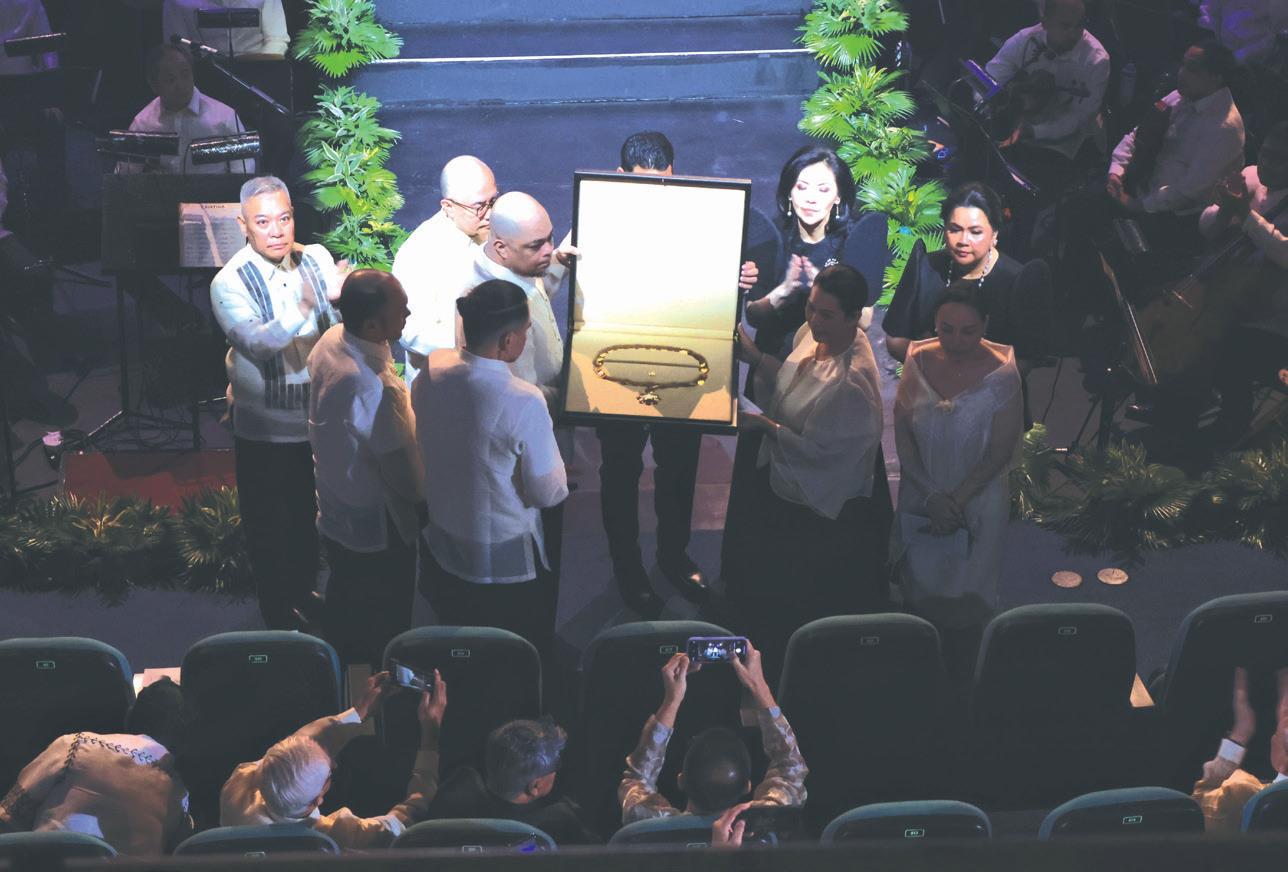







By Ricky Gallardo
THIS is perhaps one of the most difficult pieces to write. Moreso, to do so on a week when the metropolis is so quiet, when the silence seems eerie, and the summer heat sweltering, almost searing.


I’ve sat in front of my desktop for a good half an hour now, not sure how to start this piece.
Nora Aunor, National Artist for Film and Broadcast, the one and only superstar of Philippine entertainment, and a personal friend, has passed on in the middle of the observance of Holy Week. She breathed her last at the confines of The Medical City, less than 24 hours from a medical procedure that was supposed to fix her good heart.
Her children shared that Aunor passed away due to acute respiratory failure, and those who have known her knew that she was diagnosed with chronic obstructive pulmonary disease (COPD) many years ago, a common lung disease that causes restricted airflow and breathing problems.
Not long ago, Aunor shared with us that she flatlined for almost three minutes in late 2022 when she was rushed to a hospital for difficulty of breathing. “I was telling the ER people to just give me the high-flow oxygen therapy but it took them so long that I passed out, and the next memory I had was waking up in the ICU and being told that I ‘died’ for almost three minutes before I was revived,” she told us in Filipino. Since then, her health was regularly monitored but she admitted that she felt that her system continued to deteriorate. For many years now, she’d send her ’polite no’ to most of the invitations that requested her presence, and would only agree to intimate meetings with close and trusted friends from work. She had a wheelchair and an oxygen tank always on standby.
MY first close encounter with Aunor happened in the 1990s, when I interviewed her in her home for a piece I was doing. I was “warned” by my colleagues to be prepared to wait for her as she “normal” does not care about agreed time. I was happy to know that she agreed to do the interview at her Balete Drive home since it was quite near from where I stayed. It was mid-afternoon and I was led to the sala by the househelp that opened the gate. In less than five minutes, Aunor came down, in T-shirt and short shorts, sat beside me, held my hand, and whispered, “Kwentuhan lang tayo ha,” and then asked the househelp to serve me merienda. To break the ice, she immediately asked if I wanted brandy, and I said it might be too early, adding, “Hindi bagay sa sandwich, Ate Guy.” Our kwentuhan lasted until


after dinner, and by that time that it was almost done, she started calling me Nonoy (a Bicolano term for younger brother). “Parangparehong nangungusap ang mga mata natin, kaya simula ngayon Nonoy na ang tawag ko sa iyo ha. She’d invite me to come to her house if she was free to chat, and she was also the one who introduced me to the late Fernando Poe Jr.. “Magkakasundo kayo nyan ni Nonoy—ayawngbrandy,peromalakas sa beer!” she teased Poe, and Aunor laughed at the way I blushed. She moved to many houses after selling the Balete Drive property during a low point in her life, but we’d remain in touch. We even planned a major solo concert for her before the millennium, which she was so excited about. She immediately approved the full title of the show, Palabra de Aunor (A Promise Fulfilled), a one-night-only show which was supposed to be at the Cultural Center of the Philippines, with the Philippine Philharmonic Orchestra playing for her. Sadly, some forces with political connections didn’t allow that to happen at the onset of preparations, and Aunor was so disappointed and hurt. “May humarang Nonoy, pero huwag na tayo malungkot, malay natin,” she reassured me.
HUGS & BRANDY
THEN in 2010, Aunor lost her golden voice due to a botched surgery in Japan, and when we saw each other after that, she told me that our dream concert might never happen anymore. That night she told me, I remember I had brandy, much to her surprise. Then she hugged me really tight before I went home. Nora Aunor was the kind of friend who will be there for you even if you don’t see each other for months. She’d always asked about my mom, and if I already had a love life. She’d ask about new actors and how they were and how they’d treat me and my fellow writers. She’d extend help quietly especially to those whom she knew personally when she finds out that they needed some assistance.
By the time this comes out, Nora Aunor has been laid to rest with full military honors at the Libingan ng mga Bayani, and all we have are beautiful memories of a great artist, one whose level of generosity matched her immense talent. Like of all us, she was not perfect, and like many of us she loved to a fault. Godspeed, Ate Guy. From tonight onwards, I will count you among the stars.

SM Supermalls brings first-in-Cebu culinary experiences to life
CEBU’S dynamic food scene is evolving—and SM Supermalls is proud to lead the charge.
With a longstanding commitment to redefining the malling experience, SM has become the home of first-in-Cebu dining concepts, global brands, and Michelin-recognized names. From the shoreline views of SM Seaside City Cebu to the central buzz of SM City Cebu and SM JMall, a new era of culinary discovery has arrived.
“We’ve always believed that Cebuanos deserve nothing less than the best—and the first,” says Steven T. Tan, President of SM Supermalls.
“Through curated dining experiences and thoughtfully chosen food partners, we’re transforming how people dine, gather, and connect in Cebu.”
Dining firsts at SM Seaside City Cebu
AS one of the largest lifestyle destinations in the Visayas, SM Seaside City Cebu has been at the forefront of introducing Cebu to international food powerhouses like Hawker Chan, the world’s first Michelinstarred hawker stall, and Tim Ho Wan, Hong Kong’s famed dim sum destination.
Now, it continues to elevate the experience with Cibo, which recently opened its first-ever in-line store in Cebu—a welcome addition for fans of fine Italian fare with Filipino flair.
Joining the roster is Lugang Café, now officially open and serving its famed xiao long bao and Taiwanese classics to Cebuano diners for the first time.
Elevated flavors at SM JMall
SM JMall is carving a new space in Cebu for sophisticated, modern, and globally recognized culinary brands. Among the exciting firsts is Hoshino Coffee, the beloved Japanese café chain renowned for its hand-drip brews and soufflé pancakes—a true Japanese indulgence now found in Cebu.
Also making a mark is Yakiniku
Like, the solo-dining yakiniku experience that’s taken Asia by storm.
This first-in-Cebu grill restaurant invites you to enjoy high-quality meat and fast service—ideal for the
on-the-go yet quality-conscious Cebuano lifestyle.
But perhaps the biggest news comes in the form of Twist & Buckle—the churro specialist recognized by the Michelin Guide for three consecutive years (2023, 2024, and 2025). This premium comfort food destination is set to raise the bar for Cebu’s gourmet casual scene.
The heart of local flavor meets global trends at SM City Cebu OVER at SM City Cebu, ABACA Baking Company takes the lead as the first-ever café concept within an SM mall. With its handcrafted pastries and strong Cebuano roots, ABACA is a proud local gem serving global-quality coffee and comfort food.
This April, Starbucks is set to unveil a first-in-the-Philippines store concept, inspired by modern native Filipino design—a seamless blend of cultural pride and contemporary aesthetic. Also arriving this April is Tavolata, the celebrated homegrown Italian restaurant making its SM debut.
Looking ahead to May, foodies can anticipate the Cebu debut of powerhouse names from The Moment Group—Ooma and Manam—offering bold Japanese flavors and nostalgic Filipino dishes with a twist, respectively. Wolfgang’s Steakhouse, world-renowned for its USDA Prime dry-aged beef, and Nagi Izakaya, a creative take on Japanese pub fare, will also open their doors—another first in Cebu, all under one roof.
SM Supermalls has always taken great care in ensuring that each new brand complements the Cebuano's discerning tastes, values, and lifestyles. Whether it’s the convenience of solo-dining concepts, the community atmosphere of family-style restos, or the visual richness of native-inspired design, these food experiences are designed for the Cebuano lifestyle.
To know more about SM Supermalls’ new offerings, visit www. smsupermalls.com or follow @SMSupermalls on social media.






